What Do The Star Trek Uniform Colors Mean & Why Are They So Important?
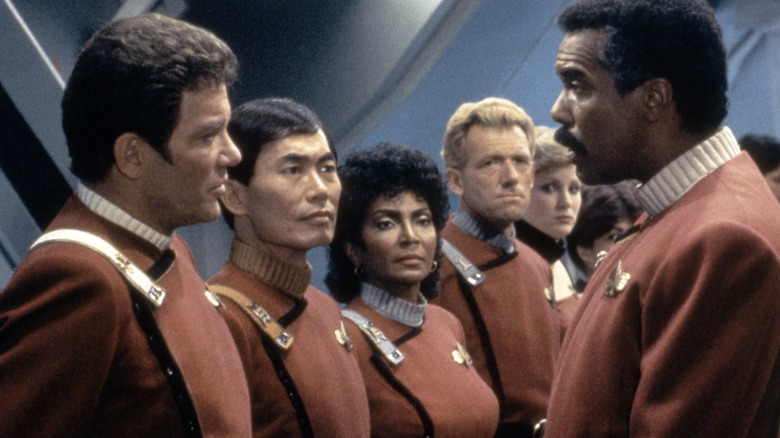
"Star Trek" is definitely a technicolor wonderland of a show. That sense of eye-catching brilliance trickles down from the background scenery to the props used by each cast member, all the way to the uniforms the show's central crew wears as a part of their duties.
It's easy to notice that the crew of the Starship Enterprise wear tunics in varying shades. Those colors are quite important — they denote which job class each crew member belongs to. Those classes were devised by series creator Gene Roddenberry and costume designer William Ware Theiss, and are intended to resemble the classifications used by the United States Military on noise-heavy aircraft carriers.
Sometimes there are differences allowed for dress uniforms; the command staff, for instance, will wear green uniforms during formal occasions. And these rules aren't hard and fast ones; across the whole universe of "Star Trek" series, films, and other ephemera, the colors various officers wear on the show and the meanings behind them change depending on when the scene takes place in the show's general timeline. But these are the color codes that most often denote each character's job on the ship, and the ones used during the original "Star Trek" series to explain who is who and what they do.

The term 'red shirt' gained a negative connotation
Even if you're not a "Star Trek" fan, you've probably heard jokes about how often red-shirted officers are introduced to the show, only for them to quickly die during away missions. For a period of time, the term "red shirt" became a dirty word in the "Star Trek" world; it's gone on to take on a larger cultural significance, indicating that a person is a disposable background element easy to get rid of. And yet many of the show's red-toting characters are the franchise's longest-lasting individuals. The class encompasses the engineering, security, and communication staff positions on the Enterprise. Lt. Nyota Uhura (Nichelle Nichols) and Montgomery "Scotty" Scott (James Doohan) are among the most prominent crew members who wear scarlet hues. To wear red on the bridge is definitely a high honor.
Are 'red shirts' more doomed than their counterparts? Mathematician James Grime weighed in on the subject during a talk at New York's Museum of Mathematics in 2017. A simple statistical calculation revealed that 10% of the show's red-shirted denizens die during the original show's run — compared to 18 percent of golden-shirted characters. "There is some truth in the old 'Star Trek' myth if you look at security officers ... 20 percent of security officers died. So I think the moral of the story is, if you're on the starship Enterprise and you want to survive, be a scientist," he said.
Ironically, crimson red was eventually used to denote a position of authority on the ship; the uniforms that debuted in "Star Trek II: The Wrath of Khan" place the crew in scarlet togs, with no color divisions to mark them.
Blue denotes a scientific mind
If you're feeling blue during your time on the Enterprise, then you're probably logically-minded. Throughout much of the original "Star Trek" series, blue uniforms were given to the show's science and medical officers. That's why Spock (Leonard Nimoy), Nurse Christine Chapel (Majel Barrett), and Dr. Leonard "Bones" McCoy (DeForest Kelley) can be seen sporting blue tunics throughout the series' run. The designation of blue uniforms hasn't changed much during the course of various "Star Trek" series; blue and purple shades are used to indicate ship medics in such continuations of the universe as "Star Trek: The Next Generation."
Blue was also the chosen shade for the crew uniforms in "Star Trek: The Motion Picture," with splashes of brown, oatmeal and white. This change didn't go over well with the cast. Their rebellion against the baggy uniforms went beyond their alleged unsightliness; costume designer Robert Fletcher sewed shoes into the bottom of each uniform, forcing the actors to ask their assistants for help in completing simple tasks such as going to the bathroom. A change was promptly made for the next film, and the red Navy-style uniforms stuck with the whole movie franchise until "Star Trek: The Next Generation" was launched.
Golden shirts denote power
Captain James T. Kirk (William Shatner), meanwhile, sports a gold-colored shirt. These are the outfits worn by those in command: largely, captains and other figures of authority. In other iterations of the show, gold tunics are worn by members of the ship's security staff. In any event, it's a uniform that denotes power.
But those shirts weren't actually intended to be golden at all; in reality, they were pale green tunics that were filmed as golden or orange-looking thanks to the sort of film the show used. According to an interview conducted with Bill Thiess in 1988 for Star Trek Prop Authority , it wasn't the show's intent to present Kirk and other captains as wearing gold at all. "It was one of those film stock things; it photographed one way – burnt orange or a gold. But in reality was another; the command shirts were definitely green." Unfortunately, thanks to that mistake the look has stuck, and Kirk's uniform is more often remembered as golden instead of green.
Whether they're sporting green or dodging danger in red, there's one thing officers on the Enterprise definitely know how to do – look stylish in a timelessly classical way.
What Do the Different Uniform Colors Mean on ‘Star Trek’?
By jason serafino | mar 30, 2023, 3:23 pm edt.
Gene Roddenberry may have dreamed of a perfect future when he created Star Trek , but parts of his vision were firmly rooted in the real world, specifically in the physical makeup of the crew of the Enterprise itself.
Roddenberry, along with the show’s producers, decided to take numerous cues from the United States Navy when creating the official ranks on the show, including a captain overseeing a crew made up of a commander, a handful of lieutenant commanders, lieutenants, and several subordinate roles. But it’s the different colors of the Starfleet uniforms that really tell the story of how the Enterprise operates.
Fans know the basics: an array of blue, red, and gold shirts line the bridge of the ship every episode. Those colors weren’t just randomly picked for the sake of diversity, though. They actually correspond to the ship’s various service roles . The gold shirts are worn by the command division, which includes Captain Kirk, Lieutenant Sulu, and Pavel Chekov. Red uniforms belong to the engineering/communications division, including chief engineer Scotty and communications officer Uhura. The blue shirts are worn by the science/medical staff, including McCoy and Spock .
As with everything in Star Trek , though, it’s a lot more complicated than all of that. In addition to the red shirts belonging to engineers and communications personnel, they are also assigned to the security division. What’s the purpose of the security division on the Enterprise ? Well, they’re usually the supporting characters who are immediately killed whenever the crew is confronted by a new enemy. This is something of a running gag for fans of the franchise, as whenever one of the “Red Shirts” is seen on screen, you know they’re not long for this world .
Also, those gold shirts worn by Kirk and crew might not have been so gold after all. According to an interview with Star Trek ’s costume designer, William Theiss, the idea was for the show’s uniforms to be red, blue, and green. In fact, on the set, Kirk’s outfit certainly looked to be an avocado (or lime) green, but the end result was a little different when the studio lights finally hit the uniform.
“It was one of those film stock things,” Theiss said, “it photographed one way—burnt orange or a gold. But in reality was another; the command shirts were definitely green.”
This might come as a surprise to Trek fans until you remember that Kirk actually did wear green on a few occasions, including the times he was in formal dress and his seldom-seen alternate green get-up, seen in the clip below.
These alternate uniforms were all the exact shade of green Theiss describes, but they were made from a different material than the standard Enterprise shirts and apparently had no issue retaining their natural color scheme when lit on set. The gold shade may have been a production mishap, but the color has since entered the Trek canon as the official hue of Kirk and his command staff. So, in the Star Trek universe, Kirk wears gold; in the real world, though, the bridge of the Enterprise was designed with a completely different color palette in mind.
It gets more confusing when you look at the later Trek series, like The Next Generation , which had the command staff in red and operations in yellow—basically the reverse of the original series. Then, of course, the movies switched costumes and colors with nearly every entry, including the powder blue monstrosities worn in Star Trek: The Motion Picture .
Roddenberry’s eye for detail was unique for sci-fi TV at the time, and everything on the Enterprise had a specific purpose. Despite some production fumbles, ill-fated redesigns, and inconsistencies later on, the colors that make up Starfleet’s uniforms tell a story that many viewers probably never even noticed.
A version of this story originally ran in 2016; it has been updated for 2023.
What Star Trek Uniform Colors Mean Throughout the Franchise's Eras
Star Trek's uniforms have undergone a staggering variety of changes over the years. The famous tricolor coding, however, has remained intact. Mostly.
Quick Links
The original series' uniforms helped star trek 'pop', the movies made radical changes to the star trek uniforms, the next generation brought back the tricolors with a twist, deep space nine and voyager gave the design a 'fatigues' look, star trek: enterprise altered the look yet again, discovery bridged the gap between enterprise and tos, picard continued the tricolor tradition, star trek: prodigy delivered new cadets uniforms, lower decks gives the tri-colors a humorous twist, strange new worlds perfectly balances old and new.
- Star Trek's uniforms have evolved throughout the decades over the course of the franchise.
- The meanings behind the colors have shifted throughout the Star Trek eras, but most series generally stick to the tri-color format.
- Each new Star Trek series has brought its own unique take on the main crew's uniforms while still providing visual connections between the eras.
From its earliest incarnation, Star Trek has used its distinctive uniforms to help stand apart from other science fiction epics. Over time, they became as important to the franchise as the phasers and transporters: particularly the unique "tricolor" patterns of red, blue and yellow. Every series has its own version, and the specific designs vary as a way of making each series distinctive.
The colors themselves have very specific meanings, though that has shifted from show to show and from design to design. Most of the time, it sticks to the basic parameters set by The Original Series , with the colors designating different departments comprising Starfleet. But a few big changes have come and gone as the franchise has evolved over the years.
Updated on March 22, 2024 by Robert Vaux: New Star Trek series have been released since the article's first publication. It has been updated with several new entries accordingly, and the formatting has been adjusted to meet CBR's current guidelines.
'The Phone Didn't Ring': Walter Koenig Reflects on Career Struggles After Star Trek
The two Star Trek pilots -- "The Cage" and "Where No Man Has Gone Before" -- established the basics of Star Trek 's uniform colors. But the tones were muted and understated, and the rapid expansion of color TV in the 1960s demanded something that popped. The Original Series brightened the colors while formally distinguishing what each one meant: red for security and engineering departments, yellow for command and flight control, and blue for science and medical. The Kelvinverse reboot movies starring Chris Pine use the same color coding for their redesigned variants of the classic uniforms.
William Shatner also wore a wraparound green tunic on occasion, as well as a formal uniform composed of green fabric. (The color disparity resulted from lighting and film stock at the time, which made the green fabric look yellow.) Other departments wore color-coded formal uniforms of the same cut. In addition, enlisted crewmen wore coveralls loosely coded to the department where they worked, and variations such as red workout uniforms would crop up as well. No special significance was attributed to their colors.
Star Trek: The Original Series
In the 23rd Century, Captain James T. Kirk and the crew of the U.S.S. Enterprise explore the galaxy and defend the United Federation of Planets.
The first Star Trek movie opened over a decade after The Original Series ended, and changing times meant a change in the look. The tricolors went out the window starting with Star Trek: The Motion Picture in favor of muted, neutral tones such as brown, beige, and sky blue. No particular significance was connected to specific colors. Instead, the Star Trek symbol on the uniform's left breast contained a color circle behind the delta, coded to match the wearer's department.
Those uniforms proved too wishy-washy and prompted another redesign. The "monster maroons" made their debut in Star Trek II: The Wrath of Khan , patterned after classic naval uniforms of the 19th century. Every officer's outer tunic was the same deep red, with the color of the shirt below indicating department and duty. White was for command, light green for medical, gold for engineering, dark green for security, dark blue for operations, gray for science, communications, and navigation, and red for NCOs and cadets. Though radically different, the uniforms made for a winning look and remained with the original crew throughout their movie adventures.
Star Trek The Next Generation: When Does TNG Get Good?
Star Trek: The Next Generation took the opportunity to return to the tricolors of The Original Series , though the cut and pattern underwent a big change. That cemented the red, blue, and yellow as a definitive part of Star Trek: so much so that the franchise's introduction now features the tricolors streaming behind the starships onscreen.
As with The Original Series , the colors each denoted different departments on a starship, with one key change: red now indicated command and helm, with yellow for security and engineering. (Science and medical stayed blue.) That came partially as an attempt to reverse the infamous "red shirt" stigma, but it also had a very practical purpose: stars Patrick Stewart and Jonathan Frakes looked much sharper in red than yellow.
Star Trek: The Next Generation
Set almost 100 years after Captain Kirk's 5-year mission, a new generation of Starfleet officers sets off in the U.S.S. Enterprise-D on its own mission to go where no one has gone before.
Star Trek: Deep Space Nine arrived toward the end of The Next Generation 's run and brought a variation to the now-established uniforms. The tricolors moved to the top of the outfit, leaving everything black below the shoulders and a standard gray shirt underneath. That helped the show distinguish itself visually from its predecessor. The new uniforms were intended to serve as Starfleet's "fatigues," workaday outfits for the more rough-and-tumble world of Deep Space Nine . Star Trek: Voyager used the same design throughout its run, and it also appeared in Star Trek: Generations .
Star Trek: First Contact delivered yet another change, with the gray moving to the outer garment and the undershirt now colored to denote department. Deep Space Nine adopted this design during its later seasons, though Voyager -- trapped in the Delta Quadrant -- pointedly did not. In every case, the colors never changed their meaning, denoting the same departments that they did in The Next Generation.
Star Trek: Deep Space Nine
In the vicinity of the liberated planet of Bajor, the Federation space station Deep Space Nine guards the opening of a stable wormhole to the far side of the galaxy.
Star Trek Voyager
Pulled to the far side of the galaxy, where the Federation is seventy-five years away at maximum warp speed, a Starfleet ship must cooperate with Maquis rebels to find a way home.
Star Trek Theory: Picard Retconned the Divisive Enterprise Series Finale
The renaissance that started with The Next Generation concluded with Star Trek: Enterprise : a prequel covering the early days of humanity's interstellar exploration and the founding of the Federation. The officers donned uniform blue coveralls reminiscent of submarine crews. Colored piping indicated the crew member's department: matching the The Original Series' coding for red, blue and yellow.
In addition to distinguishing Enterprise 's crew from that of other shows, the redesign was intended to connect the "classic" Star Trek uniforms to the fashions and patterns of the modern world. It also made a soft nod to the monster maroons of the Star Trek movies. More importantly, it indicated the political differences between the human fleet and future allies like the Vulcans who had not yet joined Starfleet. The ship's two alien members -- T'Pol and Dr. Phlox -- are markedly not in uniform.
Star Trek: Enterprise
A century before Captain Kirk's five-year mission, Jonathan Archer captains the United Earth ship Enterprise during the early years of Starfleet, leading up to the Earth-Romulan War and the formation of the Federation.
When Star Trek: Discovery re-launched the franchise in 2017, it faced a conundrum for its uniforms. The show was set between the "blue coveralls" era of Star Trek: Enterprise and the classic look of The Original Series (and eventually Star Trek: Strange New Worlds ). The first two seasons found Starfleet still wearing blue, though they resembled more formal military uniforms than the coveralls of Enterprise . Metallic piping on the sides denoted department: gold for command and helm, silver for sciences and medical, and copper for engineering and security.
In Season 3, the crew of the Discovery shot forward to the 32nd century, where they assisted in rebuilding a shattered Federation. That resulted in another series of redesigns, incorporating new variations of the tricolor patterns. Red indicated command, gold was for operations (including helm), blue for sciences, and white for medical.
Star Trek: Discovery
'keep being noisy': picard star provides star trek: legacy update.
The remaining shows in the latter-day Star Trek renaissance -- Star Trek: Picard, Star Trek: Lower Decks and Star Trek: Prodigy -- have adopted the same design philosophy as The Next Generation era. Each series features unique uniform designs patterned around the tricolor formula to denote department. Every series' look is unique, but the specific use of color coding remains true to the era in the timeline: matching the specific departments as used in The Next Generation .
Picard includes a number of key characters who weren't in Starfleet -- at least when the series began -- and as such, it de-emphasizes the tri-color look as much as possible. It helps protagonists in uniform still visibly match their colleagues. It also lets Picard show a side of the Star Trek universe outside of Starfleet, something that helps distinguish it from other series in the franchise.
Star Trek: Picard
Star Trek: Prodigy similarly takes place outside the bounds of the Federation, at least in the early episodes. Its protagonists are a band of young runaways, who escape a planetary labor camp by stealing a wayward Starfleet vessel. In the course of their adventures, they learn Starfleet's mission and commit to upholding it, despite no training and no official rank.
It also introduced cadet uniforms for its young crew. They were black and gray, without any specific color coding. It helped distinguish the crew from Admiral Janeway's, who spent most of the first season in pursuit of them and who wore variations of The Next Generation- era uniforms.
Star Trek: Prodigy
A group of enslaved teenagers steal a derelict Starfleet vessel to escape and explore the galaxy.
How Similar Is Star Trek: Lower Decks To Rick and Morty?
Star Trek: Lower Decks is intended as a parody, but it's also canonical, which means it treats its characters and their mission just seriously enough to convincingly put them alongside their live-action counterparts in other series. Final proof arrived in Strange New Worlds Season 2, Episode 7, "Those Old Scientists," in which Lower Decks actors Tawny Newsome and Jack Quaid played their characters in live-action form alongside Christopher Pike and his crew.
Their uniforms adhere to the standard Starfleet color scheme from The Next Generation era. ( Lower Decks takes place a few years after the final Next Generation theatrical film.) The cut features a narrow black top and the wearer's department color across the chest and torso, along with black trousers. Canonically, the uniforms are for crew members working on California- class ships, which are largely relegated to second-tier missions and maintenance duties.
Star Trek: Lower Decks
The support crew serving on one of Starfleet's least important ships, the U.S.S. Cerritos, have to keep up with their duties, often while the ship is being rocked by a multitude of sci-fi anomalies.
Star Trek: Strange New Worlds faces continuity challenges the likes of which no other Star Trek series has encountered. Set after the first two seasons of Discovery and a few years before the events of The Original Series , it needs to keep in step with continuity while still forging a distinctive identity for itself.
That extends to the uniforms, which match the same color patterns as The Original Series. Captain Pike is seen in the same yellow as WIlliam Shatner's Captain Kirk -- sometimes in the green wraparound -- with the rest of his crew wearing the same colors as those who will eventually replace them aboard the U.S.S. Enterprise. It has also made the notable move of eliminating the infamous "miniskirts" that female crew members wore on The Original Series. Though Nichelle Nichols made the look iconic, it has subsequently been criticized for its objectifying qualities. Strange New Worlds loses the skirts -- the series' women wear trousers just like the rest of the crew -- while still subtly evoking the style in the new cut.
Star Trek: Strange New Worlds
The Star Trek franchise is currently streaming on Paramount+.
The Star Trek universe encompasses multiple series, each offering a unique lens through which to experience the wonders and perils of space travel. Join Captain Kirk and his crew on the Original Series' voyages of discovery, encounter the utopian vision of the Federation in The Next Generation, or delve into the darker corners of galactic politics in Deep Space Nine. No matter your preference, there's a Star Trek adventure waiting to ignite your imagination.

Starfleet uniform
- View history

Starfleet uniforms in 2371, showing two separate styles in use at once
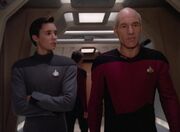
A provisional officer's uniform alongside a standard duty uniform
Starfleet uniforms were uniforms worn by individuals serving in the Federation Starfleet , originally a United Earth organization. These uniforms facilitated the wearers' needs as both scientists and researchers , as well as Starfleet's military role. The uniform and combadge used by Starfleet personnel may vary by the ship or facility they were assigned to, or the officer's rank or department. These were often retained even when visiting other Federation locations. ( TNG : " The Child "; DS9 : " Homefront ", " Tears of the Prophets "; LD : " We'll Always Have Tom Paris ", " Kayshon, His Eyes Open "; DIS : " Saints of Imperfection ")
Casual duty attire also allowed for considerable variation of uniform aboard a Starfleet vessel, though it was ultimately up to the captain's discretion. Wearers were expected to abide by the Starfleet dress code , though special exceptions were sometimes made for certain aspects of an individual's cultural heritage, such as Worf 's Klingon baldric , Nog 's Ferengi headdress , and the earrings of Ro Laren , Kira Nerys , and Shaxs . ( VOY : " Learning Curve ", et al.) According to Elim Garak , " I think Starfleet should allow their officers more latitude in accessorizing their uniforms. You'd be surprised what a nice scarf can do. " ( DS9 : " Broken Link ")
On two occasions, the term " Federation uniform " was used to describe Starfleet uniforms.
In 2369 , the Bajoran civilian Mullibok , who was being evicted from his home , asked Commander Benjamin Sisko how many Federation uniforms he planned on sending down to have him removed. ( DS9 : " Progress ")
In 2372 , Chakotay referred to his as a Federation uniform as he explained to Kar how it was like the Jal name that the Kazon earned. Chakotay told him that his uniform was earned through " years of study ", and " learning about science and ships and navigation , " adding too, that he was further taught to be "[..] prepared us to defend ourselves in battle. They prepared us very well. And we had to pass many difficult tests before we were given the right to wear the uniform. " ( VOY : " Initiations ")
- 1.1 Command
- 1.2 Operations
- 1.3 Sciences
- 2.1.1 Type #1
- 2.1.2 Type #2
- 2.1.3 Type #3
- 2.1.4 Type #4
- 3 Uniform variations
- 4 Dress uniforms
- 5.1.1 Design
- 5.2 Ambiguous uniform
- 5.3 External links
Divisions [ ]
Starfleet uniforms were classified by color among the command, sciences, and operations divisions. Occasionally, the uniforms were also broken down by department, while displaying rank insignia conspicuously. The color scheme had varied over time throughout Starfleet history, but the uniforms were designed for comfort even in the most extreme environments. ( DS9 : " Trials and Tribble-ations ", " Let He Who Is Without Sin... ")
Command [ ]
The command division was the head of Starfleet, with most of the ranking officers in Starfleet Command wearing these colors. Generally, this division was responsible for the administration of starships , starbases , and space stations .
Operations [ ]
The operations division was the backbone of Starfleet, encompassing the engineering , security , and support departments. This division was responsible for technological innovation and for maintaining and defending the Federation.
Sciences [ ]
The sciences division was the heart of Starfleet, composed of the exploratory , medical , and mental health departments.
Uniform styles [ ]
Unknown eras [ ].
These Starfleet uniforms were introduced between the 24th and 31st centuries .
Type #1 [ ]

A female officer in an unknown uniform
This uniform was worn by an operations division officer , as seen in a photo within the Transporter Facility maintained by Chief Petty Officer Carlton Dennis . ( LD : " Grounded ")
Type #2 [ ]
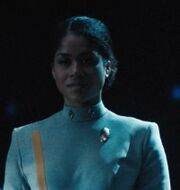
A female junior officer in a uniform from an unknown era
This uniform was worn by one of Tal 's hosts . ( DIS : " Forget Me Not ")
Type #3 [ ]
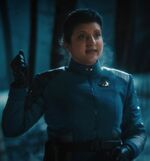
A holographic representation of a female lieutenant
This uniform was worn by officers in an unknown era. ( DIS : " Su'Kal ")
Type #4 [ ]
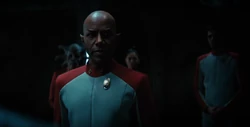
Holographic representations of officers in uniforms from an unknown era
This uniform was worn by the delegation welcoming the Kelpien and Ba'ul Alliance into the Federation. ( DIS : " Su'Kal ")
In the 23rd century , similar uniforms had been in use as cadet outfits. ( DIS : " Through the Valley of Shadows ")
Uniform variations [ ]
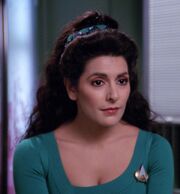
Troi in her casual attire
Some officers wore alternate uniforms. Deanna Troi often wore casual clothing while on duty, and T'Pol retained her original Vulcan uniform with a few concessions to her Starfleet rank and ship assignment. Other officers, such as Worf, Montgomery Scott , and Ro Laren, were allowed to wear accessories relating to their culture with their uniforms, but this was at the discretion of the captain. Uniforms were also altered to accommodate non-humanoid officers, such as the three-armed, three-legged uniform of the Edosian Arex , and the uniforms for beluga whales Kimolu and Matt . ( ENT : " Borderland "; Star Trek II: The Wrath of Khan ; TNG : " Ensign Ro "; TAS : " Mudd's Passion "; LD : " First First Contact ")
Uniforms were also adapted to environmental or atmospheric conditions. When exploring the planet Tyree , Benjamin Sisko and colleagues wore long, flowing gown uniforms to deal with the sand . They featured a colored stripe to represent departments. ( DS9 : " Shadows and Symbols ")
Dress uniforms [ ]
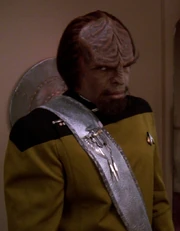
Worf wearing his dress uniform with a Klingon ceremonial sash
Dress uniforms were a variant of the standard Starfleet uniforms worn for special occasions, such as weddings , courts martial , funerals , and the greeting of ambassadorial delegations and heads of state. ( TOS : " Court Martial ", " Journey to Babel "; TNG : " Lonely Among Us ", " Manhunt ", " Data's Day "; DS9 : " Move Along Home ", " Rules of Engagement "; VOY : " Course: Oblivion ", " One Small Step ", " Ashes to Ashes "; Star Trek: Insurrection )
Appendices [ ]
Background information [ ].
Patrick Stewart 's character of Jean-Luc Picard has appeared in more styles of Starfleet uniform than any other character on screen without story contrivances (like time travel , holodecks , or alternate timelines ) being involved.
For most of Star Trek 's history, Starfleet uniforms have had at least three division colors. Some characters have worn different division colors in different episodes. Leslie , Jae , Tom Paris , Harry Kim , and Sylvia Tilly have each been shown wearing three colors at different points (including, for Paris and Kim, alternate timelines and holodeck scenarios); however, the first character to wear all three division colors in one episode was Ensign Sam Rutherford , who wore operations gold, command red, and medical blue in LD : " Envoys ".
The Starfleet uniforms worn during Star Trek: The Original Series were designed by William Ware Theiss , who returned to design the Star Trek: The Next Generation uniforms (which were further adapted into future versions on Star Trek: Deep Space Nine , Star Trek: Voyager , and the TNG -era films by Robert Blackman ). Robert Fletcher designed the uniforms seen throughout the original series movies, with later new designs provided by Nilo Rodis .
Robert Blackman also designed uniforms worn on Star Trek: Enterprise , a design representing a precursor to those seen in TOS . The uniforms seen in Star Trek: Discovery were designed by Gersha Phillips . The uniforms in Star Trek: Picard were designed by Christine Clark .
Michael Kaplan designed the uniforms seen in Star Trek and Star Trek Into Darkness , and Sanja Hays designed the uniforms for Star Trek Beyond .
As shown in the It's A Wrap! sale and auction , a number of Starfleet uniforms have had padding to increase muscular appearance. Such cases include two costumes for Tom Paris , one racquetball costume for Julian Bashir , and a Deep Space Nine costume for Worf, to create a more Klingon appearance. According to Wil Wheaton , all the main cast members wore muscle padding during the first two seasons of The Next Generation , mainly because of the tight-fitting nature of the spandex uniforms used in these two seasons. [2]
Several prototype uniform undershirts to those seen in Star Trek II: The Wrath of Khan on were sold off on the It's A Wrap! sale and auction on eBay. [3]
Ambiguous uniform [ ]
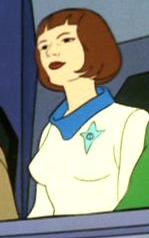
Female on the Elysian Council
A Human female seen as a member of the Elysian Council in " The Time Trap " wore a uniform of ambiguous origin. It was described in the Star Trek Concordance as "a white suit with blue collar and an insignia on the left breast," and was suggested to "possibly [be] an early Star Fleet [sic] uniform". While it is known that the Bonaventure , and possibly other Earth/Federation ships, were lost in the years prior to 2269, it is unclear if this is indeed a Starfleet uniform, and, if so, from which era it originated.

External links [ ]
- Starfleet uniform at Memory Beta , the wiki for licensed Star Trek works
- 22nd & 23rd century Starfleet uniforms at Ex Astris Scientia
- 24th century Starfleet uniforms at Ex Astris Scientia
- Starfleet uniforms at Spike's Star Trek Page
- Interview with William Ware Theiss at Phaser Resource (X)
- 3 Ancient humanoid
- Celebrities
- Secret Invasion
- The Marvels
- Disney Plus
- Apple TV Plus
- Dwayne Johnson
- Brie Larson
- Ryan Reynolds
- The Witcher
- About & Advertising
- Privacy Policy
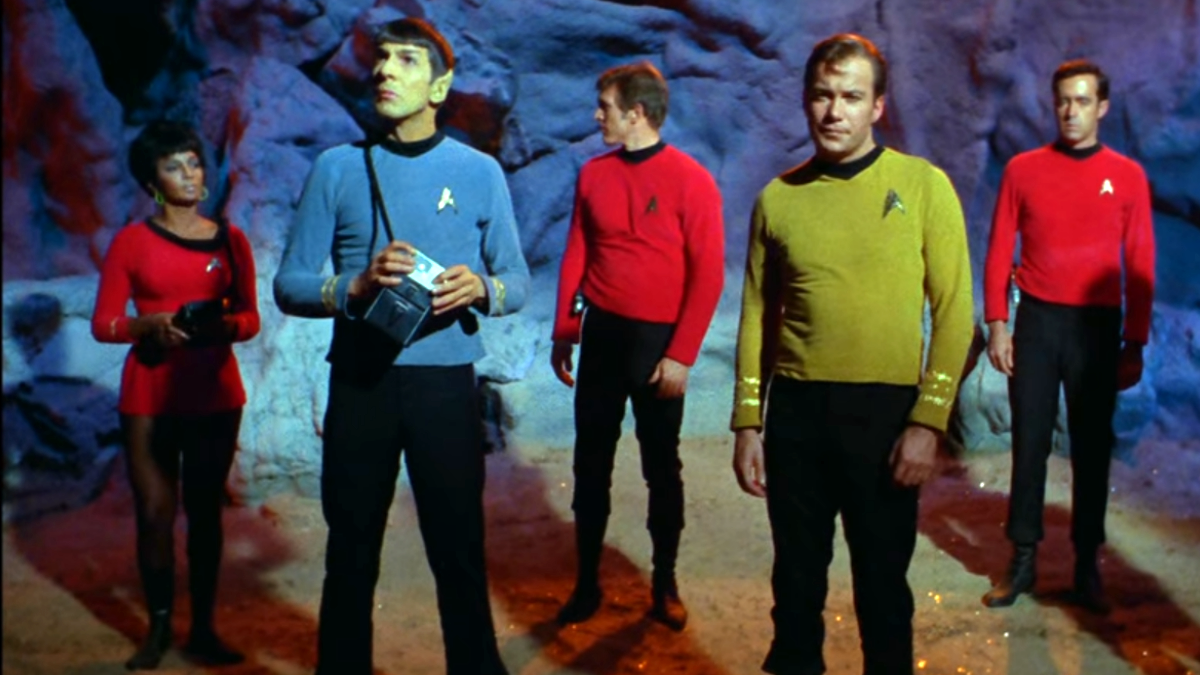
‘Star Trek’ uniform colors, explained
Everyone knows the iconic Star Trek uniforms. The brightly-colored outfits amazed viewers seeing color TV for the first time in the 1960s and helped to define the unique aesthetic style of the Star Trek universe, becoming an instantly recognizable feature of the shows.
The 23rd Century
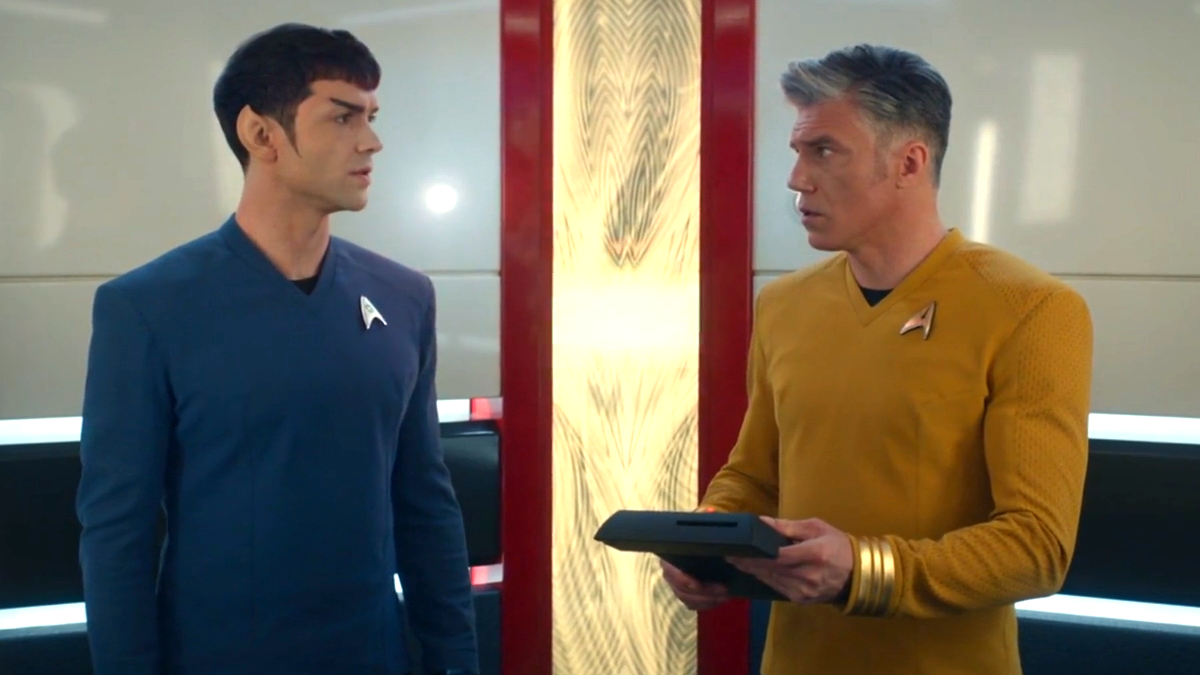
In The Original Series , there were three uniform colors . Each color represented a certain duty division aboard a starship or station. Gold, as worn by Kirk and Sulu, denoted the command division of Starfleet, which included most ranking officers and administrative personnel. Blue, as worn by Spock and McCoy, denoted the sciences division. This included researchers and medical staff. Red, as worn by Uhura and Scotty, denoted the operations division which covered a wide range of specializations such as engineering and security. Each color choice was bold and striking, meaning viewers could immediately tell what position any new character had in Starfleet.
The Original Series gave rise to the infamous phenomenon of “redshirts.” Security officers wore red shirts and would regularly put themselves in harm’s way. Enterprise crew clad in red were massively more likely to be killed than their counterparts in the other divisions. A redshirt’s life could be painful and short — they would be blown up by alien weaponry, plunge head-first into bottomless chasms, or even have all their red blood cells surgically removed by malevolent cloud creatures. Around 26 officers in red uniforms died during the course of the series’ three-year run. In the season two episode “ The Apple ,” four unfortunate redshirts are killed navigating a jungle deathtrap, being struck by lightning, shot by plants, and falling onto landmines. Even by the cruel standards of the show, this ranks as a bloodbath.
Strange New Worlds — set very shortly before The Original Series — keeps the same uniform colors, but adds a new one. A white uniform denotes someone working as a member of medical staff, but these were seemingly phased out in favor of standard blue uniforms by the time of The Original Series .
Star Trek: Discovery , a prequel series set a little further prior to The Original Series , introduced a new color-coding system. All uniforms were made of dark blue fabric, with division denoted by metallic stripes on the shoulders. These stripes were gold (command), silver (sciences), and copper (operations). These clothes were super-sleek but looked too much like Navy uniforms, and it could be hard to tell at a glance who was part of what division.
The 24th Century
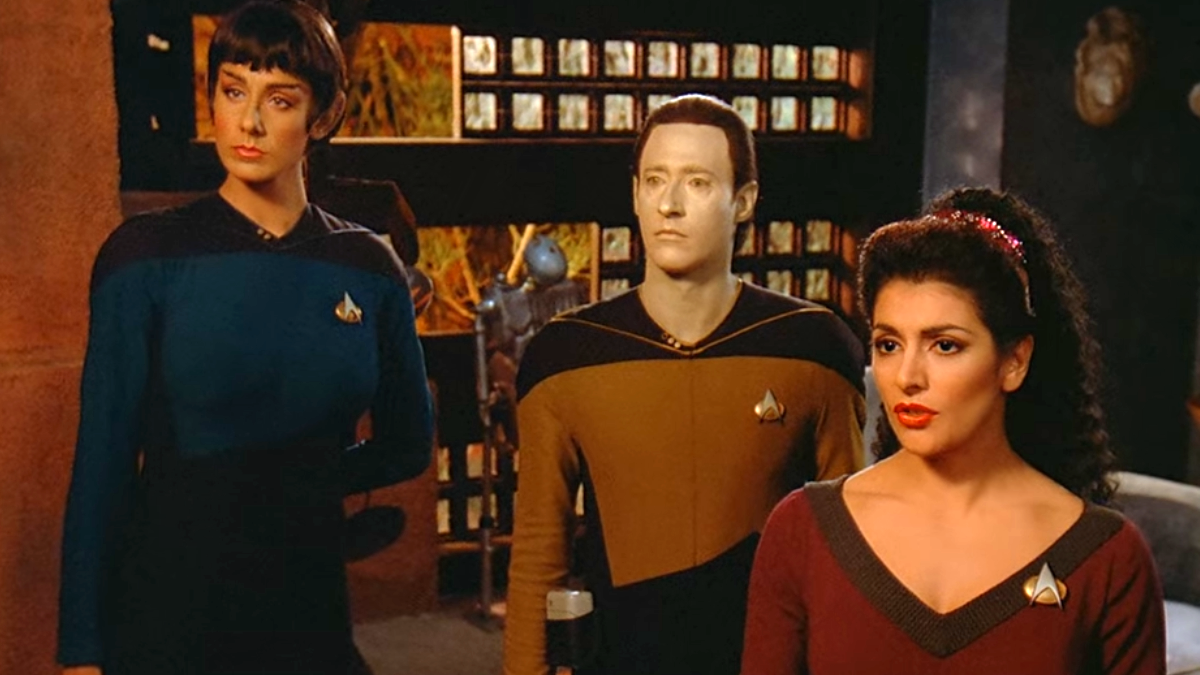
By The Next Generation , the uniform colors had changed . While blue still denoted science and medical, the meanings of red and gold were inverted. No reason was ever given in-universe for this, but the real-world explanation is that Next Generation actors looked better in certain colors — Brent Spiner as Data, for example, was deemed to look far better in gold than in red or blue. The change also came partly as a result of the Star Trek movies of the 1980s, where all Starfleet personnel were shown to wear red uniforms (the fabric for the costumes took better to red dye). Kirk had been seen wearing red for the movies, so it was felt that audiences would come to associate red with command.
Whatever the century, series, or ship, Star Trek just wouldn’t be the same without everyone clad in brightly colored pajamas. Too many modern science fiction shows have their actors wear drab, dark, soulless uniforms. Strange New World s is proudly carrying on the multi-colored tradition set way back in 1966.

Den of Geek
Why Star Trek Uniform Colors Changed From the Original Series to Next Generation
The uniforms on Star Trek have changed over time, but for reasons that make a lot more sense behind the scenes than on the Enterprise bridge.

- Share on Facebook (opens in a new tab)
- Share on Twitter (opens in a new tab)
- Share on Linkedin (opens in a new tab)
- Share on email (opens in a new tab)
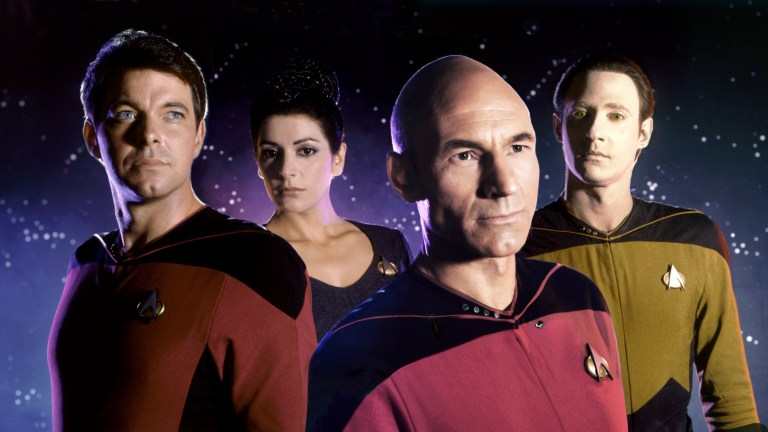
Even if you don’t know an El-Aurian from an Illyrian, even if you can’t tell the original Enterprise from the Enterprise-D, you’re probably familiar with one of the fundamental rules of Star Trek : redshirts always die.
Unlike many of the popular misconceptions about the series (Kirk doesn’t actually chase women, for example), the redshirt stereotype does have grounding in the show. Over the course of three seasons in The Original Series , 26 characters wearing red tunics died, as opposed to 15 wearing gold and blue combined. But that trend stopped with the Star Trek movies, and continued to fall away with The Next Generation and the spinoffs that followed.
Why, you ask? Because the costume colors signify a crewman’s role on their particular ship, and the color scheme changed between TOS and TNG .
Although some Trekkies hate to admit it, Star Trek didn’t really have much in the way of canon in its first few episodes. Leaving aside the infamous grinning Spock in the original pilot, it took several episodes to decide on the name of Starfleet or the Prime Directive. The same was true of the uniforms, as demonstrated by the luscious green shirt that Kirk sometimes sported.
Ad – content continues below
By the end of the series, however, the three main colors solidified into the following divisions: those in command wore gold, people such as Kirk and Sulu. Science officers and doctors, namely Spock and Bones, dressed in blue, while everyone else had red shirts. And by everyone else, that includes engineers like Scotty and security personnel, which is why they tended to get killed.
But as is so often the case with all things Trek , the uniforms weren’t entirely what creator Gene Roddenberry had in mind. Most notably, the gold uniforms were actually intended to be green, but read on camera as the color that we know today. During production of the never-released follow-up show, Star Trek: Phase II , Roddenberry wanted continuity between TOS and the new series, not only in terms of the cast, which mixed Kirk and Sulu with newcomers, but also production. In particular, Roddenberry brought back his original series costume designer William Ware Theiss.
However, when production shifted and Phase II became Star Trek: The Motion Picture , Theiss was replaced by Robert Fletcher, who designed costumes for the movie crew through Star Trek IV: The Voyage Home . Fletcher maintained some of Roddenberry’s vision for TMP , which tried to match ’70s aesthetics by giving the crew pastel pajamas. But when Nicholas Meyer took over for Star Trek II: The Wrath of Khan , Fletcher designed military-inspired uniforms to match the director’s naval warfare vision.
Although most Trekkies prefer the Meyer movies, Roddenberry hated the militarization of Starfleet and, equally important, resented the way his franchise was taken from him. So when Roddenberry regained some power for The Next Generation , he sought to right the ship, so to speak, by making Starfleet explorers again. And with it, he brought back Theiss.
For the most part, Theiss succeeded where Roddenberry and Fletcher failed in TMP . The TNG uniforms feel like ’80s versions of the ’60s original, especially after they were revised in season 3. However, with the emphasis on division colors came a confusing switch. Once again, science officers and doctors wore blue, but command now wore red while operations wore gold. Also, there’s the skant, but only Lower Decks talks about that now.
So why did the colors change? Once again, the answer is simple and almost mundane. Patrick Stewart apparently didn’t look commanding enough in yellow, while Brent Spiner , in his pale Data makeup, didn’t look good in red.
Roddenberry and the producers may have also been amenable to these changes because of the public’s changing perception of the aesthetic of Star Trek at the time. It was the massive success of Star Trek IV that gave Roddenberry the green light for TNG , and in that movie the crew wore the same civilian clothes that they sported in The Search for Spock , but during the first three Trek movies, Kirk wore red (as did Spock and the rest of the crew, because everyone wore red in Meyers’ more militarized uniforms).
Get the best of Den of Geek delivered right to your inbox!
So in the eyes of casual fans, the Captain wore red. And even Trekkies had seen enough of Kirk in red that the idea didn’t seem outlandish.
The Trek uniforms have been altered many times since. TNG and Deep Space Nine later limited colors to the shoulders, a look continued in Voyager . The TNG movies then introduced darker uniforms in Star Trek: First Contact , with division colors on the underliner, a look adopted by later seasons of Deep Space Nine .
These stories adhere to the division colors from TNG , but whenever the franchise goes back to pre- TNG era — including the J.J. Abrams reboot movies or Strange New Worlds — the TOS colors come back into play. Even the prequel series Enterprise , in which the crew of the NX-01 wears blue jumpsuits with TOS division colors on the piping. And then there’s Discovery , which began with blue uniforms and a different division color scheme, but that show started out as its own thing, anyway.
Rest assured, writers both official and on the internet have offered in-Universe explanations for the evolution of the costumes. But the best explanation is that Star Trek , as an ongoing story over six decades old, had evolved and mutated over the years, sometimes in ways that don’t make sense. And as long as some unnamed operations ensign gets killed now and again, that’s just fine.

Joe George | @jageorgeii
Joe George’s writing has appeared at Slate, Polygon, Tor.com, and elsewhere!
- Sep 7, 2023
Star Trek Uniforms: The Meaning Behind The Colors
When the original Star Trek series premiered in 1966, it wasn't just the groundbreaking storytelling that caught the audience’s attention; it was also the iconic uniforms worn by the crew. The most striking feature is the bright color scheme. The uniform colors were used to help viewers instantly recognize the roles of the crew. Command officers like Captain Kirk wear gold; science and medical officers like Spock and McCoy wear blue; engineering personnel like Scotty and security officers wear red. These colors were specifically chosen to be visually striking on the color TVs that first became widely available in the 1960s when the show first aired.
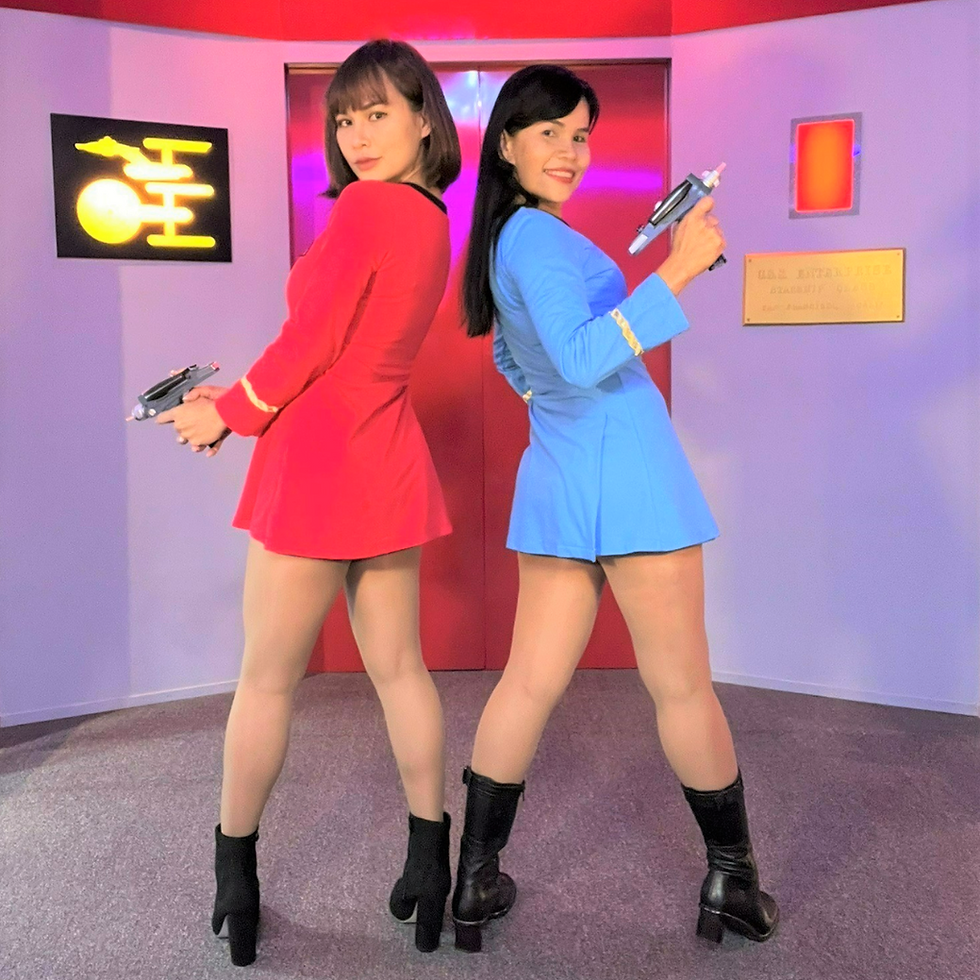
So, what was the actual meaning behind the selection of uniform colors?
Gold, worn by command officers, was chosen to symbolize the importance of strategic decisions.
Blue, worn by science and medical personnel, represents those engaged in the exploration of both outer and inner frontiers: the universe and the human body.
Red, worn by engineering crew members and security staff, stands for the heart of the ship: the people who keep it running.
With regard to the women’s short uniform dresses, these were tastefully designed, and there was an emphasis on the characters' confidence, competence, and individuality.
At that time, this marked a significant departure from the stereotypical portrayal of women in science fiction as mere eye-candy or damsels in distress. Women were portrayed as capable professionals in functional and stylish attire.
And so the choice to use different colors for the uniforms was an intentional decision to visually represent the different crew member’s functions within a team. It symbolized the show's underlying belief in a future where the clear diversity of roles and responsibilities are essential in contributing to the unified mission of successfully exploring the galaxy.
Subscribe for photos and articles
🖖😍 Star Trek Gigi
Recent Posts
The Sexy Influence of Star Trek Short Dresses
I wonder why they changed the colors in the TNG era. Maybe Red just felt like a Command color...
This was an amazing read and I now know the reasons for the colours. I love the TOS uniforms. They are my absolute favourites. If only we saw a man wearing those miniskirt uniforms to show even more diversity. That would have been awesome. Either way, the TOS uniforms looks good and served a purpose whilst not seemingly being militarised. A beautiful blog. 😊🙏🖖❤
You are very welcome, Gigi. 😍❤🖖

Star Trek Uniform Color Meanings
What is the meaning of the uniform colors in Star Trek? This post will cover the original crew, the next generation (TNG), and beyond, including deep space 9 (DS9), and Voyager.

Generally, the different uniform colors helped to differentiate between the different duty positions, levels of authority, and generally the command structure of the federation, and the crew on the starships.
In the Star Trek universe, the colors of the uniforms worn by crew members hold specific meanings. Let’s break it down:
Original Series
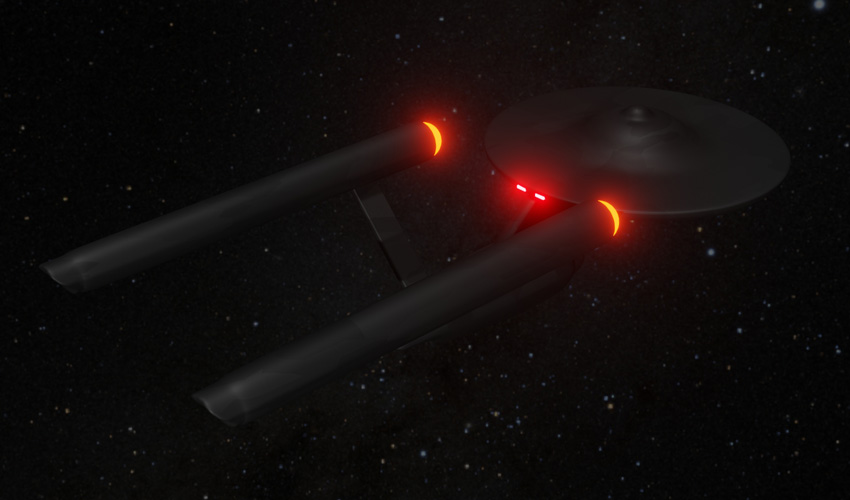
Red Uniforms: These are typically worn by crew members in engineering, security, and communications roles. Notably, Lt. Nyota Uhura and Montgomery (Scotty) Scott wore red uniforms. Wearing red on the bridge is considered a high honor. However, there’s a running joke about crew members in red shirts often meeting unfortunate fates during away missions. So, if you’re on the Starship Enterprise and want to survive, don’t wear red!
Blue Uniforms: These represent medical and science divisions. They’ve remained consistent across various “Star Trek” series. Blue shades indicate ship medics and scientific personnel.
Gold Uniforms: Worn by command officers, gold symbolizes the importance of strategic decisions. Command staff, including Captain Kirk, would wear these iconic golden shirts.
TNG, DS9 & Voyager
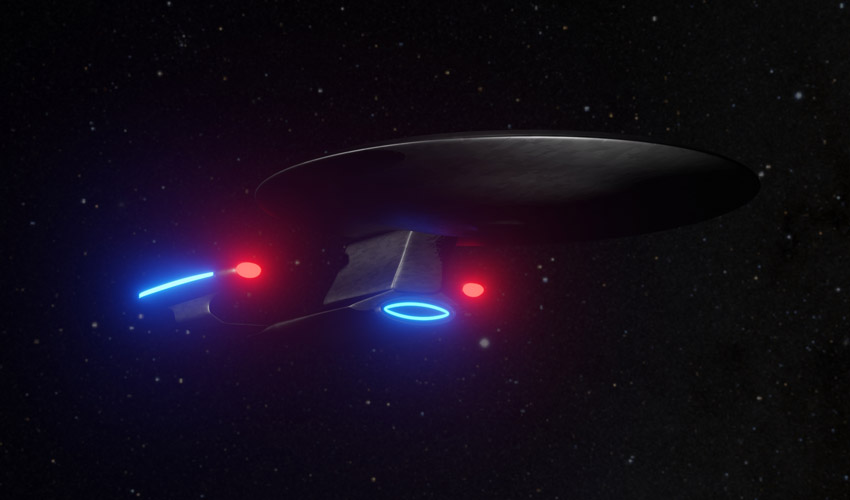
In Star Trek: The Next Generation (TNG), and beyond, not only did the uniforms modernize, the color meanings changed. Let’s delve into the significance of each uniform color:
Red Uniforms: These are worn by command staff. Captain Jean-Luc Picard and his senior officers sport these crimson hues. Red signifies leadership, decision-making, and strategic roles. If you’re in red, you’re at the helm of the starship, making critical choices for the crew and the mission.
Blue Uniforms: Medical staff wear blue. Dr. Beverly Crusher and other medical officers would have a blue uniform. This remains the same as in the original series.
Gold Uniforms: Operations and security staff wear gold. Lt. Commander Geordi La Forge, Lt. Worf, Lt. Tasha Yar, and Chief O’Brien fall into this group. Gold symbolizes efficiency, engineering, and tactical prowess. These officers keep the ship running smoothly, maintain systems, and ensure security.
In summary, the colors of Starfleet uniforms reflect the crew members’ roles and responsibilities as they explore the final frontier!
Why The Uniform Colors Change?
The switch in uniform color in the 24th century likely aimed to move away from the negative connotation associated with “redshirt” deaths, those unfortunate crew members who often met their demise during away missions.
The evolution of Starfleet’s uniform colors reflects different visions of the franchise’s costume designers over the past 50 plus years. Each new designer brings their own perspective, adapting the color meanings while honoring the legacy of this beloved sci-fi saga.
Related Colors & Posts

Similar Posts
Use of different colors in retro games.
How were colors used when it came to old retro games, why different characters had different colors? As a child I loved video games. The arcades were heaven for me as a child. I particularly found the usage of different colors fascinating in certain video games. The different colors signify different things with different meanings….
Lightsaber Color Meanings
In the world of Star Wars, the lightsaber is one of the most memorable and iconic objects within that universe. So what are the lightsaber color meanings for red, green, blue, purple and others, the weapons of the Jedi and Sith mean? Lightsabers actually get their color from what are known as kyber crystals. However,…


- [ April 12, 2024 ] Partner Spotlight: O’Hare’s Pub and Restaurant in Bartlett, IL Sporcle Events
- [ April 12, 2024 ] Partner Spotlight: Barrel House Z in Weymouth, MA Sporcle Events
- [ April 12, 2024 ] Partner Spotlight: Coach’s Pub ‘N’ Grill in Milwaukee, WI Sporcle Events
- [ April 11, 2024 ] Just Over 8 Things Google Killed Articles
- [ April 10, 2024 ] SporcleCon 2024: Introducing The Mystery Rounds! Articles
Star Trek Uniform Colors – What Do They Mean?
Space…the final frontier.
In 1964, Gene Roddenberry pitched his idea for a space-age Western to NBC. His hope was to create a science fiction series that was like “Wagon Train to the stars,” but he also wanted the show’s content to reflect some of the very real problems that were plaguing Earth at the time. He felt the show had the potential to provide viewers with a realistic glimpse into a more utopian society, one which he thought was possible for humanity if they could learn some lessons from the past.
In 1966, his vision came to fruition when Star Trek first hit the airwaves. Over time, the show would go on to earn high praise for its cultural influence. The Original Series featured one of TVs first multiracial casts, one that also portrayed women in working roles, and many have cited Star Trek as being the inspiration, at least in part, to some of the technologies we have today, like cell phones and computer tablets. We even have a new way of speaking to each other thanks to Star Trek with the creation of Klingon , the world’s most popular fictional language.
The attention to detail Roddenberry brought to creating his fictional universe was immense, and while he may have helped inspire the iPad, not everything from Star Trek has caught on just yet. Apparently, his vision of a more utopian future also included velour tops, spandex jumpsuits and plastic. Something tells us we still have a ways to go before we start seeing fashion models walking down the catwalk dressed like Worf.
While the Star Trek uniform colors might seem highly illogical , that doesn’t mean they actually lacked that same awareness Roddenberry used elsewhere in the series. In fact, a lot of thought went into the costume design. The colors and insignia on each uniform can actually be quite telling.
It turns out there is a reason you should avoid wearing a red shirt during exploration missions.
To Boldly Go Where No Costume Designer Has Gone Before
To stay in line with his vision of a realistic future, Roddenberry wanted crew members of the Enterprise, the fictional star-ship of the series, to have realistic jobs and job titles. They used the US Navy as a guide, creating comparable ranks and job structures. There was a commander, a handful of lieutenant commanders, lieutenants, and numerous other roles. The various positions were eventually learned by viewers throughout the course of the show, but it was the uniform colors that gave the real hints as to who does what on Enterprise.
The Starfleet did not have randomly assigned uniform colors. Each color actually represented one of the ship’s various jobs and service roles. Here’s a quick breakdown on the Star Trek uniform colors from the Original Series:
- The command division wore gold shirts. This includes Captain Kirk, Lieutenant Sulu, and Pavel Chekov.
- The science and medical staff wore blue shirts. This includes Lieutenant Commander McCoy and Commander Spock.
- The engineering and communications division wore red shirts. This included Chief Engineer Scotty and Communications Officer Uhura.
- The security division also wore red shirts. You might know these people as the careless supporting characters that are immediately killed whenever the crew is confronted by a new enemy. We told you to avoid them.
This all gets a little messy in later Star Trek series. In The Next Generation, for example, command staff wore red and it was the engineering and security staff that wore yellow. Each new Star Trek movie that comes out further complicates things. Costume colors switch in almost every new adaptation.
Sleeve stripes highlighted the rank of crew members. The meaning of these has also changed throughout the course of the franchise. Generally speaking, the more stripes one had on their sleeve, the higher ranking they were. So captains often wore two or three stripes, while other enlisted officers might only have a single stripe.
Gold Is The New Green
Now for the really confusing part. Remember how Captain Kirk and crew wore those gold command shirts?
The Star Trek uniform colors were originally supposed to be red, blue and green. If you pay close attention, you’ll see this was the case. Captain Kirk’s outfit was actually more of a lime green when he was on set, but under bright studio lights, it appeared gold on film. As Star Trek costume designer William Theiss describes , “It was one of those film stock things. It photographed one way – burnt orange or a gold. But in reality was another; the command shirts were definitely green.”
Despite gold being canonized in later show dialog, when the lights are off, Kirk definitely shows his true colors.
Regardless of what color they were, one has to respect the vision and contributions that Star Trek has brought to the science fiction genre. Gene Roddenberry wanted everything in his fictional universe to have a specific purpose. While the series has had it’s share of highs and lows, one has to respect the attention to detail given. Just hope you never find yourself stuck wearing one of those red shirts.
About the Author:

Mark Heald is the Managing Editor of Sporcle.com. He enjoys spending time with his family, traveling, and bemoaning the fact the Sonics left Seattle.
- Mark Heald https://www.sporcle.com/blog/author/markh/ Sporcle 2023 Year in Review
- Mark Heald https://www.sporcle.com/blog/author/markh/ Countdown to Five Billion: Wrap-Up
- Mark Heald https://www.sporcle.com/blog/author/markh/ Where Do Sporcle Events Questions Come From?
- Mark Heald https://www.sporcle.com/blog/author/markh/ A Little More - Week of 1/30/23
Related Articles

The Simpsons Trivia Team Names
(Last Updated On: March 5, 2020) The Simpsons have been around for a long time… A very long time. Over 30 years, in fact. Given its long run, it’s no wonder that the show has […]

12 Unforgettable Animated Holiday Specials
(Last Updated On: November 19, 2018) Snowfall has cast a gentle blanket on the street, people are walking around cozied up in thick scarves and hats, and though it’s cold outside, there’s a hint of […]

21 Benedict Cumberbatch Quotes You Can Creatively Mispronounce
(Last Updated On: February 28, 2021) We’re not going to lie, part of the inspiration for this post was how easily you could mash words and syllables together and have it be recognizable as Benedict […]
Copyright © 2007-2024 Sporcle, Inc.
Screen Rant
Discovery season 4 new uniforms bring back star trek tradition.
Star Trek: Discovery season 4 has changed Starfleet's uniform colors. Captain Burnham and her crew are now color-coded like the TNG-era Starfleet.
Star Trek: Discovery season 4 will debut new color-coded uniforms that properly synch up with Star Trek tradition. Paramount+'s flagship Star Trek series charted the franchise's new future when the USS Discovery jumped into the 32nd century in season 3. Michael Burnham (Sonequa Martin-Green) learned the cause of The Burn and saved the universe in Star Trek: Discovery season 3, which ended with Burnham becoming the new Captain of the titular starship and the crew donning Starfleet's 32nd century-era grey uniforms .
Since Star Trek: The Original Series , color coding (because the 1960s TV series took advantage of new color television technology) was a fixture of Starfleet uniforms. As a starship Captain, James T. Kirk (William Shatner) donned a gold uniform to denote Command. Mr. Spock (Leonard Nimoy), as Science Officer, and Dr. Leonard McCoy (DeForrest Kelley) wore blue, which was the color of Sciences and Medicine. Montgomery Scott (James Doohan) wore red as Chief Engineer, as did the various members of the starship's Security (who often died and were nicknamed Red Shirts). The Star Trek TOS movies broke this tradition; Star Trek: The Motion Picture introduced monochrome grey uniforms and then Star Trek II: The Wrath of Khan changed to naval-themed crimson uniforms that the TOS cast wore for the rest of their films. When Star Trek: The Next Generation premiered, it brought back color-coded uniforms but swapped red as the color of Command and gold became the color of Engineering. Star Trek: Deep Space Nine and Star Trek: Voyager maintained this color scheme with their jumpsuit uniforms. Star Trek: Enterprise debuted blue jumpsuit uniforms but kept gold, blue, and red stripes to denote each officer's specialty.
Related: Star Trek: Every Starfleet Uniform And History Explained
Star Trek: Discovery s eason 4's trailer revealed that the 32nd-century Starfleet changes uniform styles again and go back to proper color-coding. Captain Michael Burnham and the crew of the USS Discovery have traded their grey uniforms, which had a color stripe denoting their division, as well as their prior blue uniforms, which they lost at the end of season 3. The new Discovery season 4 uniforms are now red for Command, Gold for Operations and Security, and Blue for Sciences, similar to the 24th-century TNG -era color scheme. Additionally, there's now a dark stripe down the right side of each uniform's torso.
One significant break in tradition is the uniforms worn by Discovery 's Medical team. Dr. Hugh Culber (Wilson Cruz) and his staff wear white uniforms with a blue stripe to denote the Medicines division. Star Trek: Discovery 's doctors have deviated from the Star Trek tradition of medical staff wearing Science blue since season 1. Culber has always worn a white uniform, and that is continuing in the 32nd century (despite white being an odd color choice for a profession that deals with blood of different colors, depending on the patient being human, Vulcan, or another alien species).
Like Star Trek: Enterprise , Star Trek: Discovery 's crew wore blue Starfleet uniforms from seasons 1 to 3. In fact, Discovery 's blue uniforms were retconned to be standard in the show's original timeframe of 2255. The traditional color-coded TOS- era uniforms were then introduced in Star Trek: Discovery season 2 when Captain Christopher Pike (Anson Mount) and the USS Enterprise joined the show. However, Pike changed from his gold uniform to Star Trek: Discovery 's blue suit for the duration when he left the Enterprise to take command of the Discovery. The 32nd century has now come full-circle in Star Trek: Discovery season 4 so that Captain Burnham now sports the same colors as Captains Picard (Patrick Stewart), Sisko (Avery Brooks), and Janeway (Kate Mulgrew).
Next: Everything We Know About Star Trek Discovery Season 4
- Stranger Things
- The Lord of the Rings

From TOS to Star Trek Beyond: The Evolution of Uniforms
From its humble – and somewhat precarious – beginnings in 1966, Star Trek’s place in science fiction has grown to epic proportions, unmatched by others in its genre (which, of course, is a bone of contention).
Arguments aside, there’s one constant element in Star Trek that we cannot do without: their wonderfully designed uniforms. I have to admit – there’s not much sexier than a person in uniform. Especially if they’re in Star Trek.
I’m not saying outlandish alien features and costumes don’t add to a story’s appeal, but Star Trek’s crew members – from TOS to Star Trek Beyond – hit the spot with their simple but “look at me” vibe.
So, how well do you know your Star Trek uniforms?
If your memory is a little hazy, let’s help you with that. Here is a Star Trek uniform guide which showcases the threads from The Original Series, The Motion Picture, The Next Generation, Generations, Deep Space Nine, Voyager, Enterprise, and the most recent movies.
Perfect timing for Star Trek Beyond, don’t you think?

Which uniforms do you like best?
Related: Which Star Trek Villain Are You?
Related Topics
Gaming trailers, more like this.

Rocket League | Star Wars Droids Gameplay Trailer
Latest trailers.

Redfall | “Welcome to Redfall” Official Trailer
Related posts, more in tv & movies.
Guide: Uniform colors
- VisualEditor
- View history
This guide was created to help players stick to the original canon colors and uniforms as seen in the various series and films. Since then it has been expanded to include canon in-game uniforms and their coloration. The canon colors presented in this guide have been heavily tested against the in-game lighting and matched for accuracy with similar lighting in the shows. Notice that they have been labeled as per the usual positions the colors were used to designate in the shows and movies, not by the generalized Tactical, Engineering and Science careers they are used to designate in game.
For those that crave more accuracy, it was created using a Dell E198WFP Monitor with the Color preset Normal and Color Profile sRGB IEC61966-2.1 (default settings for most PCs and Monitors).
Note that additional uniform guide entries have been added by other user(s), so Dell Monitor usage will not apply to all entries.
Index: [ | ]
- Canon Uniforms
- Mirror Universe Uniforms
- Section 31 Uniforms
- 25th Century Uniforms
- 25th Century Cadet Uniforms
- 2410 Odyssey Uniforms
- 2410 Terran Empire Uniforms
- Khitomer Alliance Uniform
- Romulan Uniforms
- Klingon Uniforms
- Canon Badges
- Alien Uniforms
- Various Armor
- Off Duty Wear
- Canon and Non-canon Starship List
External links [ | ]
- Season 9 Dev Blog #30 - Odyssey and Bortasqu' Uniforms
- Original Thread on STO Forum by Blackavaar
- 2 Playable starship
- 3 Delta Recruitment

Star Trek: Discovery Season 5 Brings Back Enterprise Captain Archer Tribute
Warning: SPOILERS for Star Trek: Discovery Season 5, Episode 1 - "Red Directive"
- Season 5 of Star Trek: Discovery pays tribute to Captain Archer from Star Trek: Enterprise.
- Archer Space Dock in Discovery serves as a hub for Starfleet upgrades and new starship construction in honor of Jonathan Archer.
- Captain Archer's legacy and impact on the formation of the Federation are essential to Star Trek: Discovery's future.
Star Trek: Discovery season 5 brought back the 32nd century Starfleet's tribute to Captain Jonathan Archer (Scott Bakula) from Star Trek: Enterprise. Star Trek: Discovery and Star Trek: Enterprise are TV series at opposite points bookending Star Trek 's Prime Universe timeline . Enterprise is set in the 22nd century and charts the pioneering voyages of the NX-01, the first Starship Enterprise commanded by Captain Archer. Star Trek: Discovery seasons 3-5 are set over a thousand years later in the 32nd century.
Star Trek: Discovery season 1 began in 2256, a century after Captain Archer's NX-01 Enterprise first set off to explore the galaxy. Although Captain Michael Burnham (Sonequa Martin-Green) and the USS Discovery's crew never met Archer, Star Trek: Discovery certainly bore the influence of Star Trek: Enterprise , especially in Discovery 's early seasons. Both series were Star Trek prequels, and Discovery 's original blue Starfleet uniforms were a visual link to the distinctive blue jumpsuits worn on Star Trek: Enterprise by Captain Archer's crew .
Star Trek: Discovery Season 5 Returning Cast & New Character Guide
Star trek: discovery brings back archer space dock, captain archer's spirit is part of the 32nd-century starfleet.
Star Trek: Discovery season 5's premiere , "Red Directive," saw the return of the Archer Space Dock. Following a mission to Q'Mau where Captain Michael Burnham, Captain Rayner (Callum Keith Rennie), and Cleveland Booker (David Ajala) were unable to apprehend couriers Moll (Eve Harlow) and L'ak (Elias Toufexis), the USS Discovery and USS Antares used their combined shields to protect a Q'Mau settlement from an avalanche. Afterward, a dusty Discovery jumped back for repairs at the Archer Space Dock near United Federation of Planets headquarters.
The goal of the Archer Space Dock is to upgrade the existing Starfleet and build the next generation of starships.
The Archer Space Dock was introduced in Star Trek: Discovery season 4's premiere, "Kobayashi Maru." The facility was unveiled by Federation President Laira Rillak (Chelah Horsdal) to the first new class of Starfleet Academy. The goal of the Archer Space Dock is to upgrade the existing Starfleet and build the next generation of starships. It was only fitting to name the Archer Space Dock after the Captain of the first Starship Enterprise, and the first Federation President, Jonathan Archer .
The Archer Space Dock is reminiscent of previous facilities that have built and repaired the USS Enterprise throughout Star Trek .
Enterprise’s Archer Is An Important Part Of Star Trek: Discovery Millennium Celebration
The federation began with archer a thousand years ago (give or take a few decades).
Although Captain Jonathan Archer wasn't name-dropped like Star Trek: The Next Generation 's Captain Jean-Luc Picard (Patrick Stewart) was in Star Trek: Discovery season 5's premiere, Archer's spirit was evoked in the Federation's Millennium Celebration . Discovery season 5 is set in 3191, a thousand and 30 years after the founding of the United Federation of Planets . Captain Archer was a pivotal figure whose voyages forged the bonds between United Earth, Vulcan, Tellar Prime, and Andoria that led to the formation of the Federation.
Captain Archer was aware of events in the 30th century as a result of his involvement in the Temporal War in Star Trek: Enterprise.
Jonathan Archer is essentially the George Washington of the Federation . After his decade-long run as Captain of the Enterprise, Archer served as the first Federation President. There would be no Federation without Jonathan Archer, and he would be pleased to know that the Federation still endures in the 32nd century. Star Trek: Discovery is forging the future in the 32nd century, but the Archer Space Dock shows the Federation never forgets it was Captain Jonathan Archer who helped it begin.
Star Trek: Discovery and Star Trek: Enterprise are streaming on Paramount+
Cast Blu del Barrio, Oded Fehr, Anthony Rapp, Sonequa Martin-Green, Doug Jones, Wilson Cruz, Eve Harlow, Mary Wiseman, Callum Keith Rennie
Franchise(s) Star Trek
Writers Alex Kurtzman
Directors Jonathan Frakes, Olatunde Osunsanmi
Showrunner Alex Kurtzman
Where To Watch Paramount+
Cast Dominic Keating, Connor Trinneer, Linda Park, John Billingsley, Scott Bakula, Jolene Blalock, Jeffrey Combs, Anthony Montgomery
Streaming Service(s) Paramount+
Writers Rick Berman, Manny Coto, Brannon Braga
Showrunner Manny Coto, Brannon Braga
Creator(s) Rick Berman, Brannon Braga
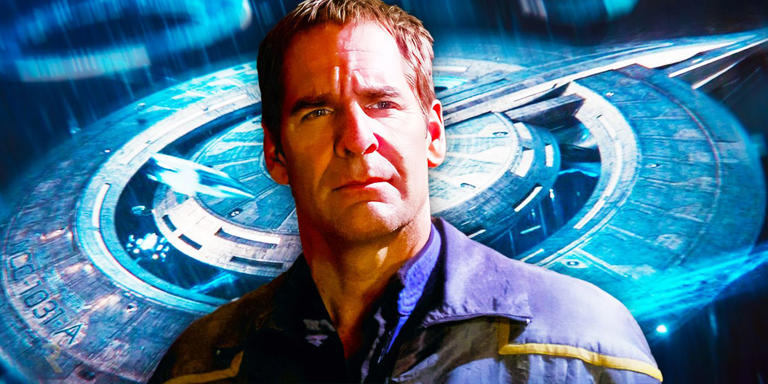
- More to Explore
- Series & Movies
Published Apr 8, 2024
Star Trek Explorer #11 Delivers A Difficult Encounter Between Captain Shaw and Seven of Nine
The latest issue of Star Trek Explorer hits newsstands tomorrow, featuring interviews with Sonequa Martin-Green, the Hagemans, and more!

StarTrek.com
Tomorrow's release of Star Trek Explorer #11 is here to deliver on all your Star Trek news!
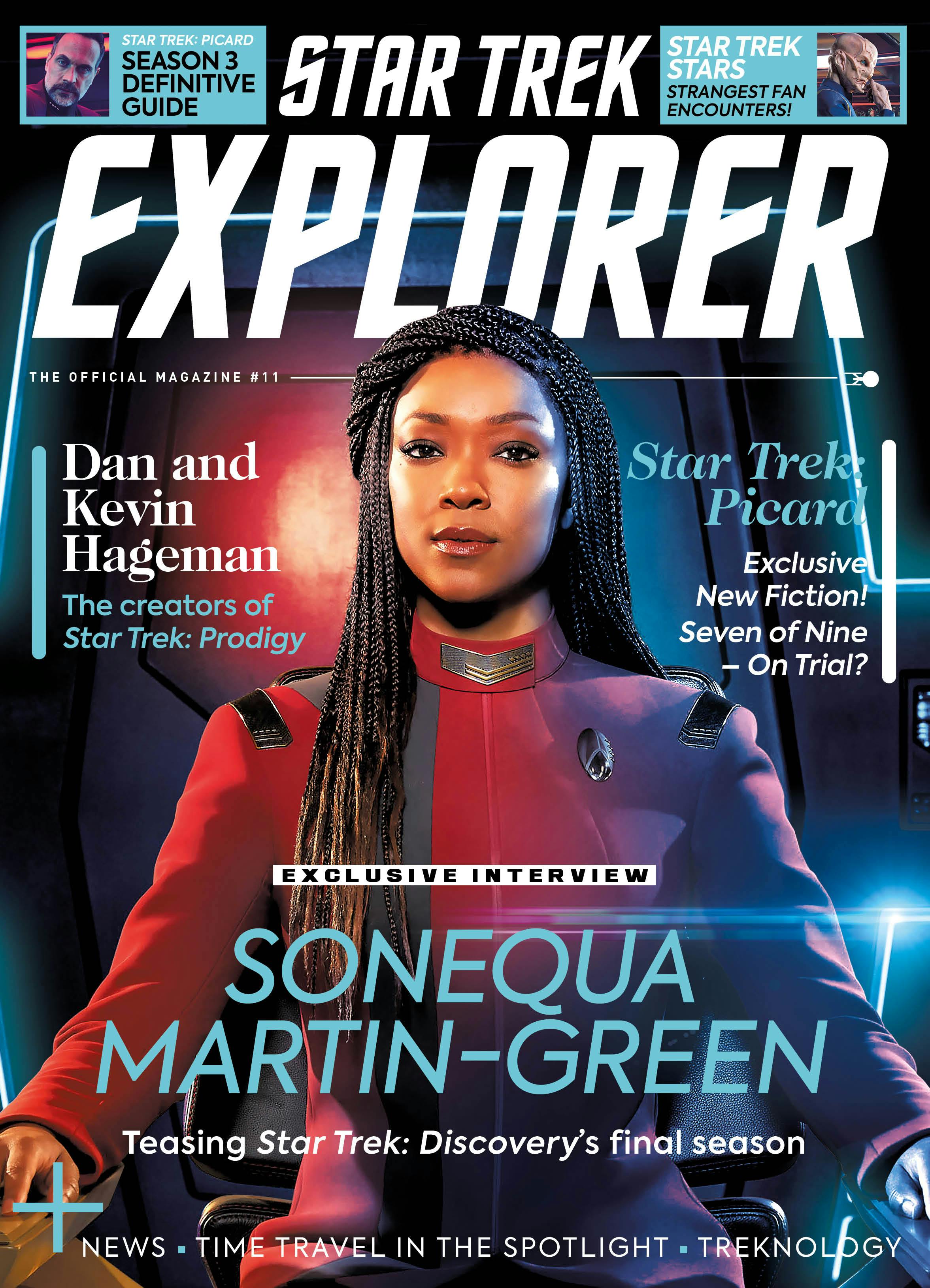
Star Trek Explorer #11 Newsstand Cover
Within the pages of the latest issue of Star Trek Explorer , dive into a handful of exclusive fiction, interviews, and features.
Star Trek Explorer #11 celebrates the final season of Star Trek: Discovery with an exclusive interview with Sonequa Martin-Green. She teases things to come as the series draws to a close, and offers some candid comments on what she hopes the legacy of the show will be.
Elsewhere, the latest issue has an exclusive interview with the Hagemans — creators of Star Trek: Prodigy ! There’s a Star Trek: Picard short story, "Confirmation Bias" by Michael Dismuke, centering on a difficult encounter between Captain Shaw and Seven of Nine aboard the U.S.S. Titan -A. And in David Mack's short story, "Dignified Transfer," it’s a sad mission for Captain Picard. All this and so much more!
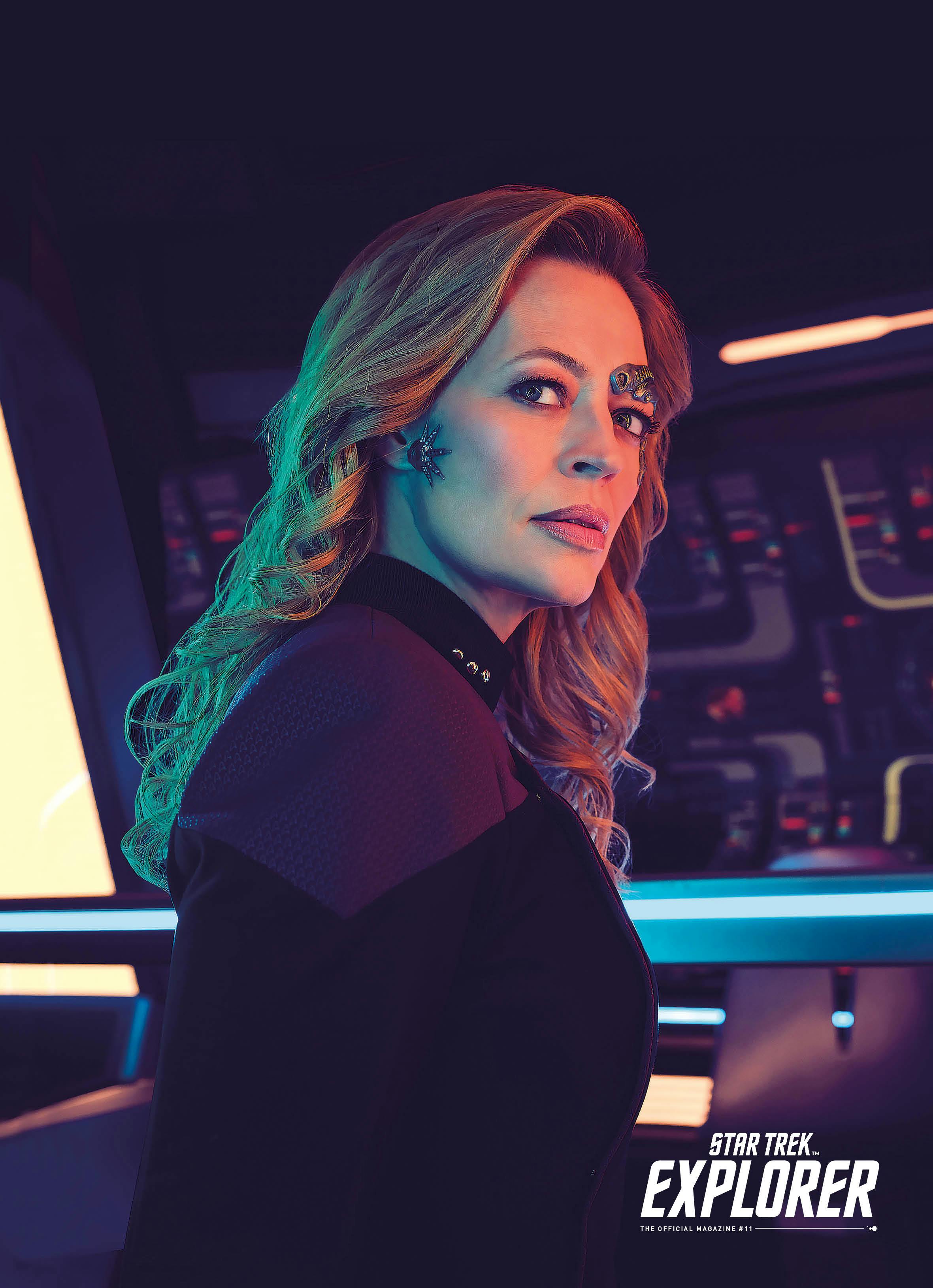
Star Trek Explorer #11 Exclusive Cover
Thanks to our friends at Titan Magazines, we have an exclusive excerpt of the short, "Confirmation Bias" by Michael Dismuke, below!
"Your vessel will be towed to Starbase G-6 where you'll be remanded into the custody of Starfleet Security. From there, a formal tribunal will be formed to decide your fate. If your planet has a judicial system, they have the right to provide for your legal defense. Of course, they might disavow you. I would, since you are such abject losers. If that happens, you'll be provided a replacement from our judge advocate general's office."
Liam Shaw, captain of the U.S.S. Titan -A, finished reading the two captives their rights.
The Usangi'I males sat in two separate but adjacent holding cells in the ship's brig. Blue-hued force fields prevented the duo of criminals from escaping. Shaw couldn't help but think that the portly prisoners, dressed in shiny orange uniforms, resembled tubby worms with the facial features of star-nosed moles – the kind he had caught as a kid back home in Illinois. In a universe shaped by the peculiarities of interstellar evolution, the faces of the Usangi'I captives looked as if a cosmic engineer had attached an otherworldly satellite dish to their snouts. Comprising thirty to forty fleshy, prehensile tendrils that splayed outward like a miniature constellation, their unique facial appendages were endowed with hyper-sensitive neural clusters. These clusters resembled minuscule antenna arrays, fine-tuned to intercept and interpret environmental signals.
The crew of the Titan- A would have preferred to learn about a new, sentient species in a more diplomatic manner. However, the actions of the Usangi'I had changed their status to that of prisoners in the brig rather than of guests on the bridge.
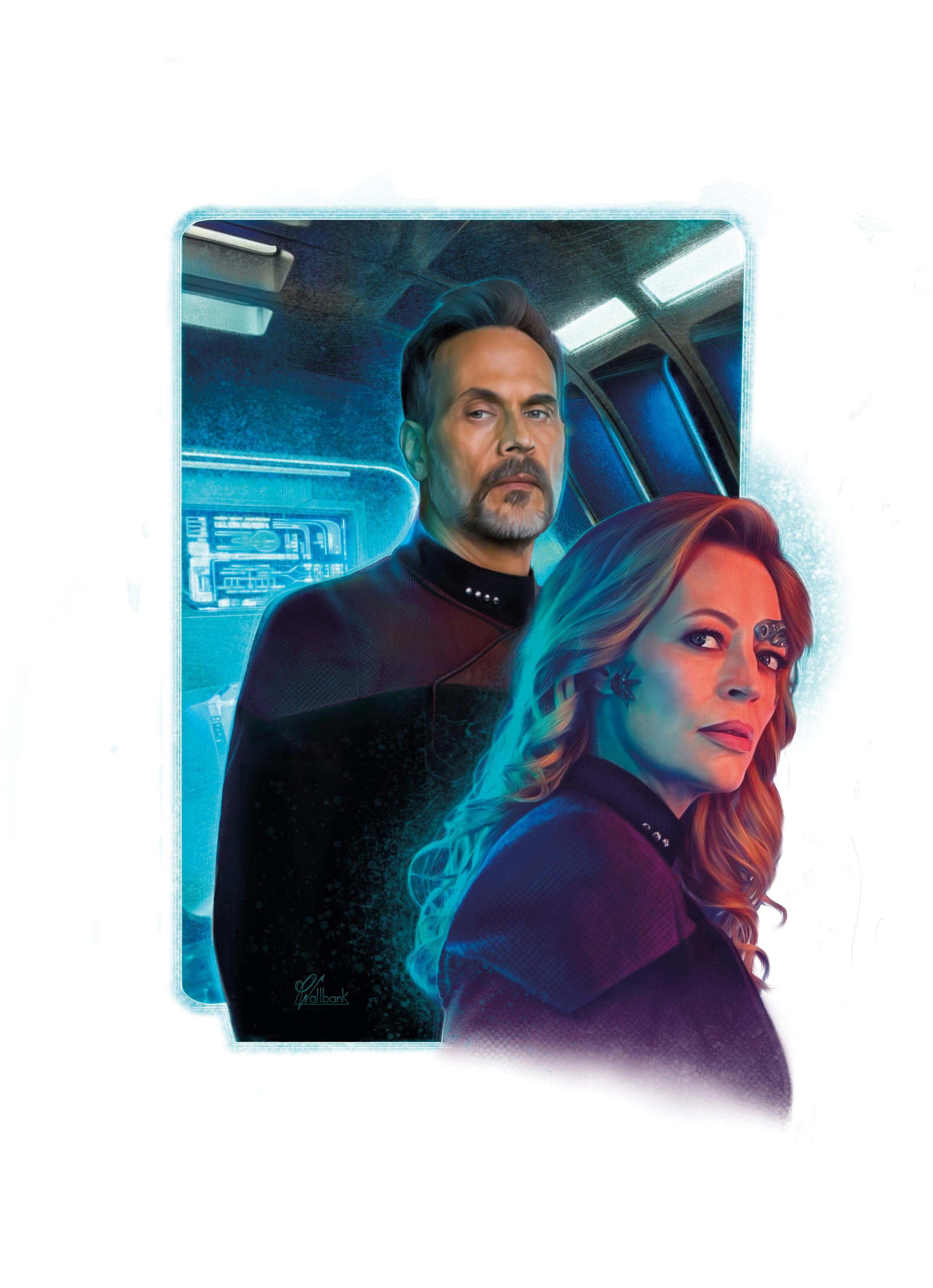
Star Trek Explorer #11 'Confirmation Bias' Artwork
"I'll make sure my chief of security sends you a few holopics of the innards of of a Federation penal colony. I'd hate to keep you in suspense regarding your new digs." Captain Shaw punched a few more notes into the PADD, signed off on the formal charges, then handed it to his first officer. "How many hours until we arrive at G-6, Commander Hansen?"
Seven checked the PADD, added her own sign off, and handed it to one of the two stern-faced security officers that stood guard. "Twelve hours, sir," she responded, silently roiling at the fact that Captain Shaw refused to refer to her by her chosen name.
Though she had thrown off the shackles of the Borg Collective, she had spent approximately half of her life as Seven of Nine, Tertiary Adjunct of Unimatrix Zero One. Once liberated from the Borg, her crewmates aboard U.S.S. Voyager called her by the abbreviated moniker "Seven of Nine" — or just "Seven" — as did her associates in the Fenris Rangers. Shaw's insistence on referring to her by birth name, Annika Hansen, ran deeper than mere accuracy and formality, though the man was a model of procedural compliance. Over the course of weeks, the tonal inflections with which he uttered her name evolved from passive-aggressive jabs to more overt micro-aggressions.
"Captain," Seven asked as they exited the brig into the bustling corridor of the Neo-Constitution -class ship, "may we speak privately?"
"I don't see why not," he responded without making eye contact.
Within short order, Shaw and Seven regrouped to the starship's Observation Lounge. Shaw rounded the conference table and sat down opposite from where Seven stood. He didn't bother to offer a seat to his first officer. With a swipe of the hand, he activated the computer built into the surface of the table and tapped away without looking up. "What can I do for you, Commander Hansen?" He swiped left, making a few selections on the console.
Seven's lips pursed momentarily in a silent symphony of agitation as the captain summoned from the ship's database Vivaldi’s Concerto For Violin And Strings In F Minor. "I would like to address what transpired during our recent contact with the Usangi’I pirates, sir."
Shaw adjusted the volume of the music to his liking. "What exactly would you like me to address?" He sat back, his eyes set for the challenge. "We made first contract with a new species. We quickly determined hostile intent. We uncovered their ruse. Now they sit in the brig awaiting Starfleet justice. Not bad for this crew’s thirty-fifth mission. If you want to take the lead in writing the report, go right ahead."
"I’m not sure you want me to write that report." She offered a moment's hesitation. "Sir."
"Is that so?" The challenge had been accepted. He leaned forward, locking his hands together and resting his elbows on the table. "Pray tell."
You can read the complete short story in Star Trek Explorer #11 on sale April 9. Plus, there's an exclusive interview with Sonequa Martin-Green looking forward to Star Trek: Discovery 's fifth and final season; the Hagemans discuss the importance of Star Trek: Prodigy ; there’s more exclusive short fiction; your definitive guide to Star Trek: Picard Season 3 and much, much more!
Get updates by email.

- Share full article

‘Star Trek’ Fan Leaves Behind a Collection Like No One Has Done Before
When Troy Nelson died, his shelves were filled to the rafters with memorabilia from the popular franchise. Soon, the massive collection will be boldly going, going, gone.
Evan Browne said her brother Troy’s love of “Star Trek” began with the original series, which he and his siblings watched at dinnertime. Credit... Connie Aramaki for The New York Times
Supported by

By Sopan Deb
- Published April 1, 2024 Updated April 3, 2024
Editors’ Note, April 2, 2024: After publication, The Times learned that Troy and Andrew Nelson were named in a civil lawsuit filed in Pierce County Superior Court in 1998, in which they were accused of molesting three disabled adults in a state-licensed facility that they operated. After a six-week jury trial, Washington State was ordered to pay $17.8 million to the plaintiffs. The state said it intended to appeal but missed the deadline and paid the victims. The Nelson brothers denied the allegations and were never criminally charged.
Troy Nelson and his younger brother Andrew were almost inseparable.
The two youngest of six, they were born two years apart. They lived together in their childhood home in Bremerton, Wash., for more than half a century. Near their home, there is a park bench on which they carved their initials as young boys.
The Nelson brothers never married or had children. They worked together at the same senior home. They even once, as teenagers, dated the same girl at the same time while working different shifts at the same pizza shop. This lasted a week until they realized it.
“Two parts of one body,” Evan Browne, their older sister, said of their relationship in an interview.
On Feb. 28, Andrew Nelson, who had been treated for cancer for years, went to feed the chickens and ducks that were gifts from Ms. Browne to her brothers. He had a heart attack and died. He was 55. Just hours later, Troy Nelson, who was stricken with grief, took his own life. He was 57.
“He had talked about it before,” Browne, 66, said, tearfully. “He said, ‘Hey, if Andrew goes, I’m out of here. I’m checking out.’ Andrew would say the same thing, and then it really happened .”

What Troy Nelson left behind has become a sensation. After his death, family members posted pictures on social media of his massive — and, really, the keyword is massive — collection of “Star Trek” memorabilia, which have now been shared thousands of times.
The items took up two living rooms and a bedroom, all lined with bookshelves, according to Elena Hamel, one of the brothers’ nieces. The centers of the rooms were lined with additional bookshelves — all packed to the brim — to create aisles. There were jewelry cabinets serving as display cases.
The shelves contained action figures. Dolls. Models of ships. Posters. Ornaments. Lunchboxes. Legos. Several toy phasers and tricorders. (For non-Trek fans, the phaser is a weapon, and a tricorder is, essentially, a fancy smartphone.) Multiple “Star Trek” lamps. (Yes, there are “Star Trek” lamps.) Trading cards. Comic books. Trek-themed Geeki Tikis (stylized tiki mugs). Life-size cutouts of famous characters. A life-size captain’s chair.
While it’s impossible to account for every private collector in the world, Troy Nelson’s collection is almost assuredly among the largest — if not the largest.
The last additions to the collection came in the final weeks of his life: Stuffed rabbits in “Star Trek” uniforms. “I’ve never seen a collection that size,” said Russ Haslage, the president of the International Federation of Trekkers , a “Star Trek”-themed nonprofit that Haslage founded with Gene Roddenberry, the creator of the franchise.
Haslage’s organization opened in 2020 a “Star Trek” museum in Sandusky, Ohio, that has received donations of memorabilia from estates. Those collections “pale in comparison” to Mr. Nelson’s, he said. (Haslage has reached out to the family to ask about donations from the collection.)
The older brother’s love of “Star Trek” began with the original series, which he’d watch with his siblings.
“It was our dinner meal,” Ms. Browne said. “When we had dinner, we were sitting in front of ‘Star Trek.’”
Troy Nelson began collecting in the late-1970s. His first acquisition was a model version of the Starship Enterprise. Then came Star Trek conventions. Why the franchise was such a draw to him remains a mystery to his family.
“I really can’t say. I mean, other than the fact that he was brainwashed with it at dinner time,” Browne said, laughing. “That sounds ridiculous. When we grew up, it’s like, ‘Dinner is at this time. And if you don’t get here at this time, you don’t get dinner.’ So it might’ve been a comfort for him .”
Troy Nelson would often monitor sites like eBay for items he didn’t have. On several occasions, he would express frustration on losing out on an item before being able to bid on it. Until he found out the reason.
“Andrew already got it for him,” Ms. Browne recalled.
Obsessive “Star Trek” fandom has long become an indelible part of pop culture, especially as the franchise — which has spawned several television series, movies, novels and comics — has been a long-running institution. There have been documentaries that have studied the subject, such as “Trekkies” in 1997. It’s been lampooned on “The Simpsons,” “Saturday Night Live” and “Family Guy,” and become a story line in an episode of “The West Wing,” among many others. For dedicated fans, accruing collectibles isn’t uncommon.
“When you collect these things, you’re closer to that genre that you enjoy so much,” Haslage said. “When I first started in 1979, I was grabbing everything I could get my hands on because it was cool, and it was a piece of the whole ‘Star Trek’ mythos. If you have these pieces, you’re a part of that universe in some way.”
It turns out that collecting is a pursuit that runs in the family.
Andrew Nelson collected mall swords, Ryobi-branded tools and statues of warrior women, like Xena, the warrior princess .
Browne’s house has a wall with thousands of smashed pennies and her living room windows are full of glass sugar and creamer bowls.
Browne’s father, Bud Peers, collected salt and pepper shakers, guns and knives. Troy and Andrew’s father, Norman Nelson, collected scrap metal and wood.
Hamel has 17 Christmas trees, all fully decorated with separate themes.
Browne’s son, Michael, who is 36, collects anything and everything related to black bears.
“ When you have a large collection like that and it’s displayed like that,” Hamel said, “and it’s something that is important to you, it’s often really calming to be in a space like that. It’s just all the things that you love. It’s soothing.”
As far as Browne knew, Troy had no history of mental illness or any previous suicide attempts. After Andrew died, she received a distraught and frantic call from Troy with the news. She told him that she was on her way.
Ms. Browne said she called him when she got to the Tacoma Bridge. No answer. And then again, at the Manette Bridge. No answer. When she reached their home, the back door was open. And then she found him. The phone call was the last time they spoke.
Troy Nelson did not leave a note, but did leave some things meticulously arranged by his computer, including a key to the house, burial plans for the two brothers, and bills.
“ I don’t know really what I thought,” Ms. Browne said. “All I could do was just scream.”
The Nelson family is boxing up Troy’s “Star Trek” collection to prepare it for auction. Andrew’s ashes will be placed in an urn carved in the likeness of the supermodel Bettie Page . (He was a fan.) Troy’s ashes will be placed in a “Star Trek” lunchbox.
If you are having thoughts of suicide, call or text 988 to reach the 988 Suicide and Crisis Lifeline or go to SpeakingOfSuicide.com/resources for a list of additional resources.
Sopan Deb is a Times reporter covering breaking news and culture. More about Sopan Deb
Advertisement

IMAGES
VIDEO
COMMENTS
Star Trek's iconic uniforms have through a variety of changes in color designation and design in the past 57 years for a variety of reasons.In Star Trek: The Original Series' unaired pilot, there were only two colors - blue for the science and medical divisions and gold for everybody else.Due to the costs involved in mounting a second pilot for the network, the gold uniforms were retained for ...
"Star Trek" is definitely a technicolor wonderland of a show. That sense of eye-catching brilliance trickles down from the background scenery to the props used by each cast member, all the way to ...
According to an interview with Star Trek 's costume designer, William Theiss, the idea was for the show's uniforms to be red, blue, and green. In fact, on the set, Kirk's outfit certainly ...
The two Star Trek pilots-- "The Cage" and "Where No Man Has Gone Before" -- established the basics of Star Trek's uniform colors.But the tones were muted and understated, and the rapid expansion of color TV in the 1960s demanded something that popped. The Original Series brightened the colors while formally distinguishing what each one meant: red for security and engineering departments ...
Star Trek uniform colors explained. The basic colors that outline Star Trek as a whole are an array of blue, red and gold. These colors line the bridge of the ship in every episode, and relate specifically to the various occupational roles that are performed on the ship. Each member wears the color that corresponds with that specific class or ...
For most of Star Trek's history, Starfleet uniforms have had at least three division colors.Some characters have worn different division colors in different episodes. Leslie, Jae, Tom Paris, Harry Kim, and Sylvia Tilly have each been shown wearing three colors at different points (including, for Paris and Kim, alternate timelines and holodeck scenarios); however, the first character to wear ...
The Original Series three uniform colors. The Original Series. blown up plunge head-first surgically removed 26 officers The Apple. Strange New Worlds The Original Series The Original Series. Star ...
The TOS uniforms are arguable the most recognized and iconic of uniforms in the canon. They are the blueprint for all other uniforms in Star Trek.While they carry some of the elements from the "The Cage" unaired pilot episode — tunic-like top, Section colors, black capri-length trousers and boots — the cut and fit of the garments are narrower, the colors much sharper and for the women ...
Because the costume colors signify a crewman's role on their particular ship, and the color scheme changed between TOS and TNG. Although some Trekkies hate to admit it, Star Trek didn't really ...
The original crew in their tri-color uniforms. In the original Star Trek series, which ran from 1966-1969 (or roughly from 2254 to 2269, in universe), there were three standard uniform colors ...
When the original Star Trek series premiered in 1966, it wasn't just the groundbreaking storytelling that caught the audience's attention; it was also the iconic uniforms worn by the crew. The most striking feature is the bright color scheme. The uniform colors were used to help viewers instantly recognize the roles of the crew.
Star Trek: The Wrath of Khan would introduce one of the longest-lived uniforms in Starfleet history. These uniforms consisted of a red jacket, white long sleeved turtleneck and black pants with red piping. It also featured the now-iconic Starfleet insignia on the left breast, as well as new rank insignia on the right shoulder.
Blue and purple shades indicate ship medics and scientific personnel. Gold Uniforms: Worn by command officers, gold symbolizes the importance of strategic decisions. Command staff, including Captain Kirk, would wear these iconic golden shirts. In Star Trek: The Next Generation (TNG), and beyond, not only did the uniforms modernize, the color ...
In "Star Trek II: The Wrath of Khan," a new standard was established, and the all-red, Christmas sweater-like uniforms would remain the standard through at least the 2350s. "Star Trek: The Next ...
Star Trek uniforms are costumes worn by actors portraying personnel of a fictitious Starfleet in various television series and films in the Star Trek science fiction franchise. During the various series, the costume design has often changed to represent different time periods and for reasons of appearance and comfort. Sometimes different styles were deliberately mixed to enhance the sense of ...
The Starfleet uniforms seen on the original "Star Trek" series back in 1966 were designed by William Ware Theiss, a costume designer who had previously worked on major Hollywood productions like ...
Here's a quick breakdown on the Star Trek uniform colors from the Original Series: The command division wore gold shirts. This includes Captain Kirk, Lieutenant Sulu, and Pavel Chekov. The science and medical staff wore blue shirts. This includes Lieutenant Commander McCoy and Commander Spock. The engineering and communications division wore ...
What does the different color of uniform shirts signify in the Star Trek movies of the reboot series? In Star Trek Into Darkness Kirk orders Chekov to wear a Redshirt in place of a Yellow one to work in place of Scotty. In the original series, the colors were a little different and also have some ambiguity but in the reboot series, there are only 3 colors used Red, Yellow, and Blue.
The new Starfleet Uniforms from Star Trek: Discovery are very distinctive and different from anything that we have seen before:. Especially their color scheme is decisively a new thing when compared to the old classic red/blue/yellow color code that represented one's department.. The new all-blue uniforms seem to be very similar, except for their shiny ornaments, that maybe also mean belonging ...
According to Bill Theiss (Senior Costume Designer for Trek TOS) the colours were chosen on the basis of complementing the complexion of the various crew members, the ready availability of material at the studio as well as the desire to ensure that the uniforms were equally distinctive in black and white;. He also confirmed that the film stock chosen would make the colours act in odd ways on ...
One significant break in tradition is the uniforms worn by Discovery's Medical team. Dr. Hugh Culber (Wilson Cruz) and his staff wear white uniforms with a blue stripe to denote the Medicines division.Star Trek: Discovery's doctors have deviated from the Star Trek tradition of medical staff wearing Science blue since season 1.Culber has always worn a white uniform, and that is continuing in ...
From TOS to Star Trek Beyond: The Evolution of Uniforms. Thu 14 July 2016 08:30. Noemi. From its humble - and somewhat precarious - beginnings in 1966, Star Trek's place in science fiction has grown to epic proportions, unmatched by others in its genre (which, of course, is a bone of contention). Arguments aside, there's one constant ...
The uniforms typically seen in Star Trek: Voyager are the Standard Duty Uniform style that was introduced in 2369 - nearly two years before Voyager found itself stranded in the Delta Quadrant.. As with other TNG-era uniforms, there are three division colors used on the uniforms: Red/Maroon - this denotes the COMMAND division. Examples are anyone on the command track, including helmsmen ...
This guide was created to help players stick to the original canon colors and uniforms as seen in the various series and films. Since then it has been expanded to include canon in-game uniforms and their coloration. The canon colors presented in this guide have been heavily tested against the in-game lighting and matched for accuracy with similar lighting in the shows. Notice that they have ...
The Uniforms . The uniforms are among the ugliest that any Star Trek show has ever featured. That's bad enough, but what's worse is that, within 10 years of the show's timeline, we'd have the ...
Star Trek: Discovery season 1 began in 2256, a century after Captain Archer's NX-01 Enterprise first set off to explore the galaxy.Although Captain Michael Burnham (Sonequa Martin-Green) and the ...
Within the pages of the latest issue of Star Trek Explorer, dive into a handful of exclusive fiction, interviews, and features. Star Trek Explorer #11 celebrates the final season of Star Trek: Discovery with an exclusive interview with Sonequa Martin-Green. She teases things to come as the series draws to a close, and offers some candid comments on what she hopes the legacy of the show will be.
Haslage's organization opened in 2020 a "Star Trek" museum in Sandusky, Ohio, that has received donations of memorabilia from estates. Those collections "pale in comparison" to Mr ...